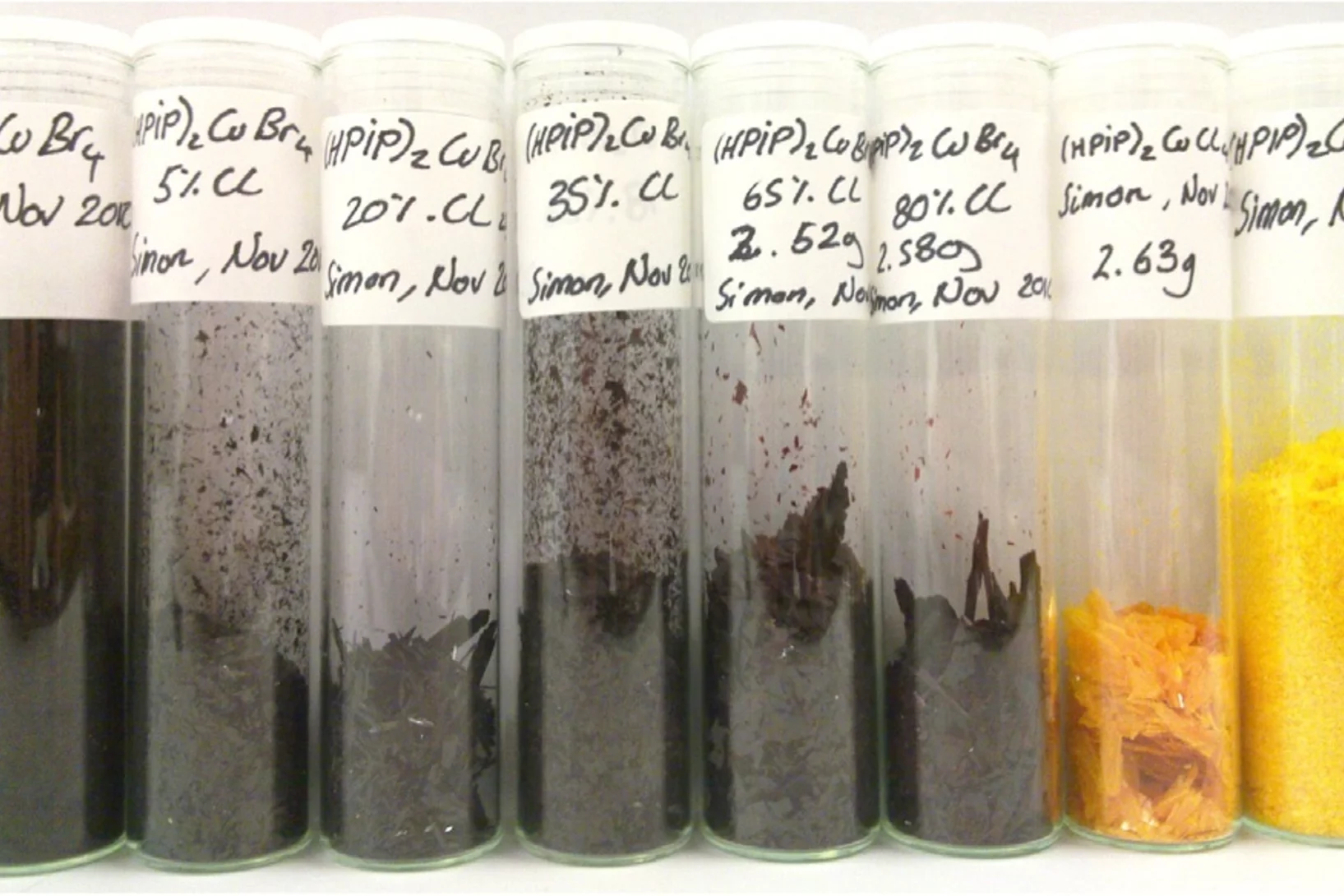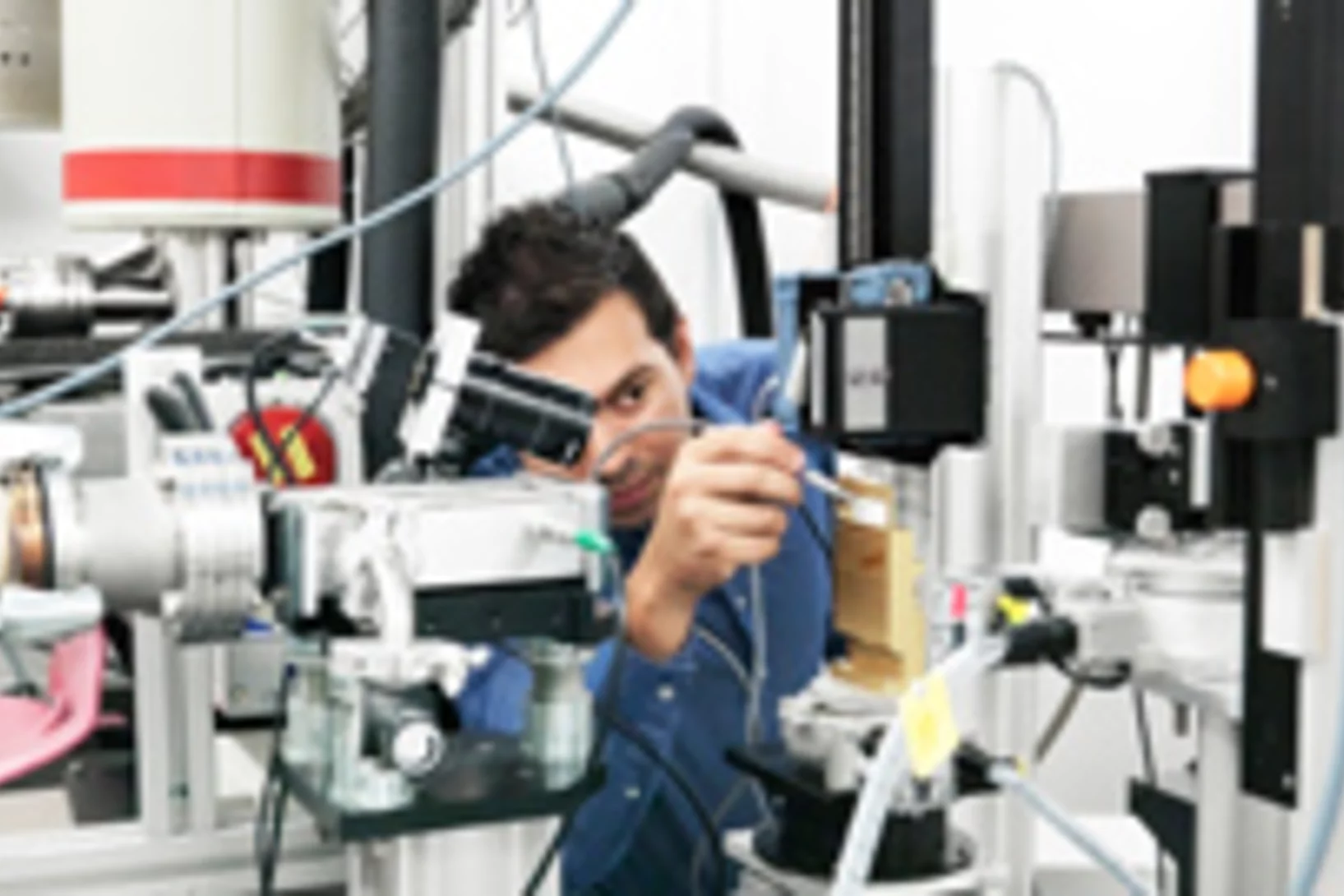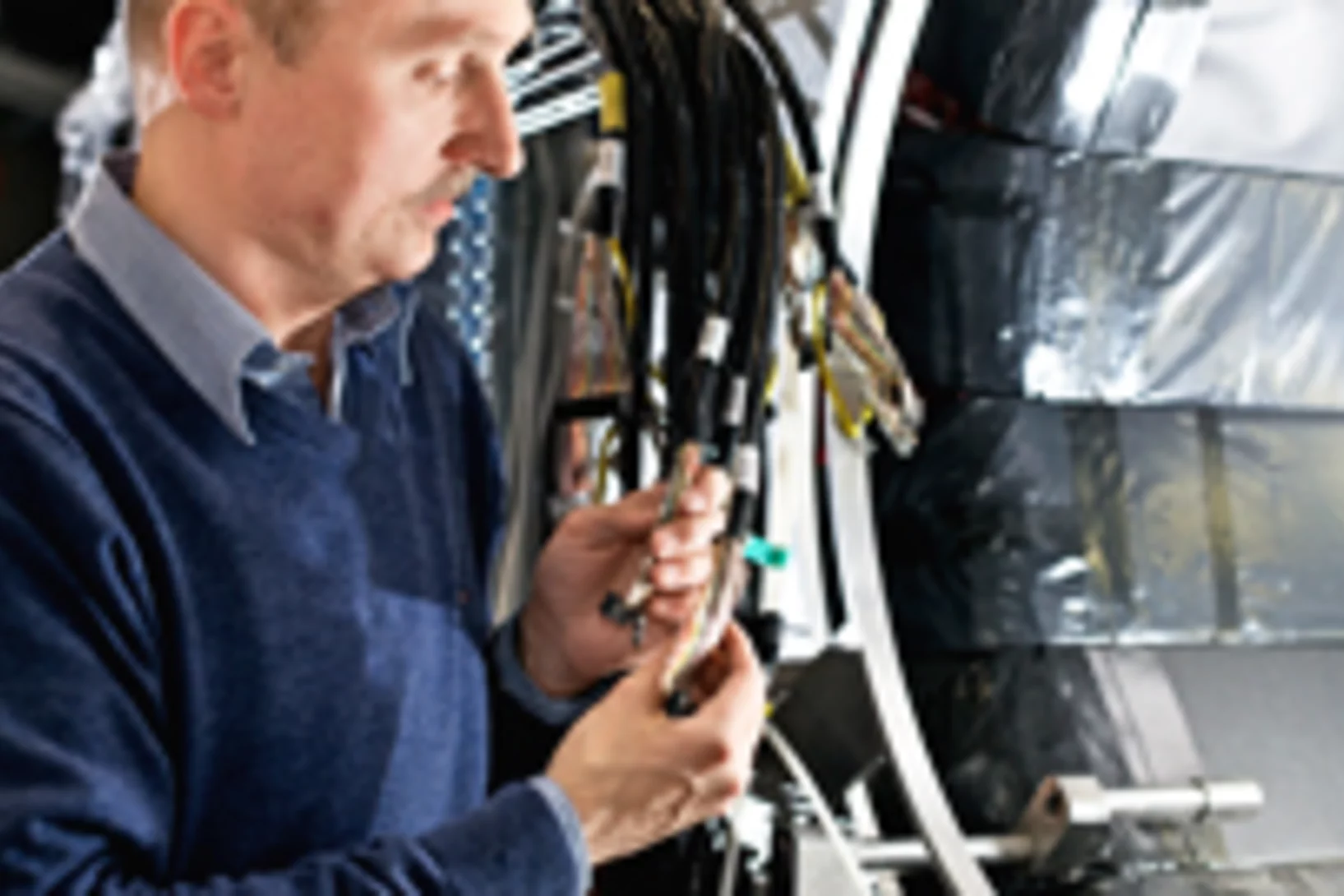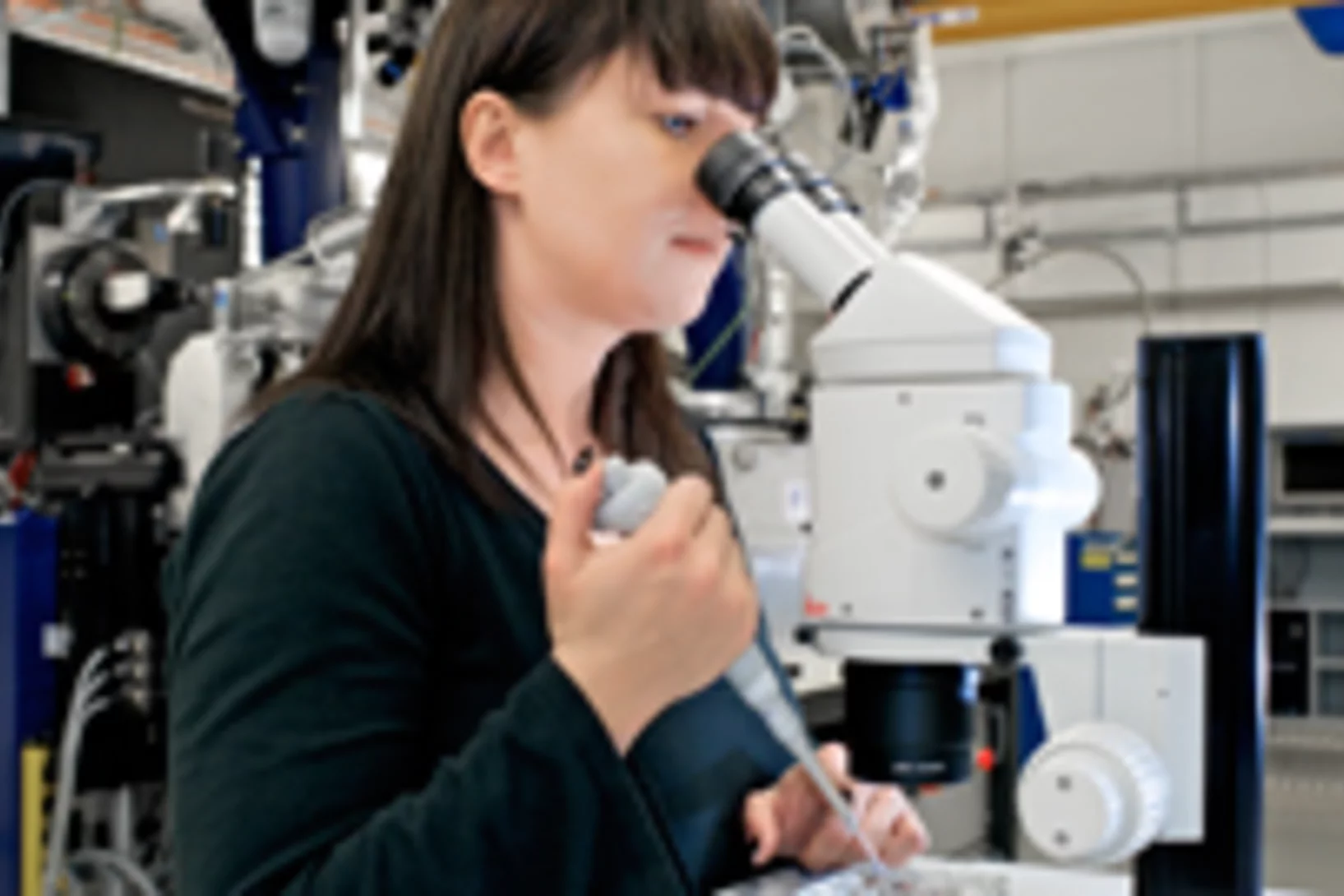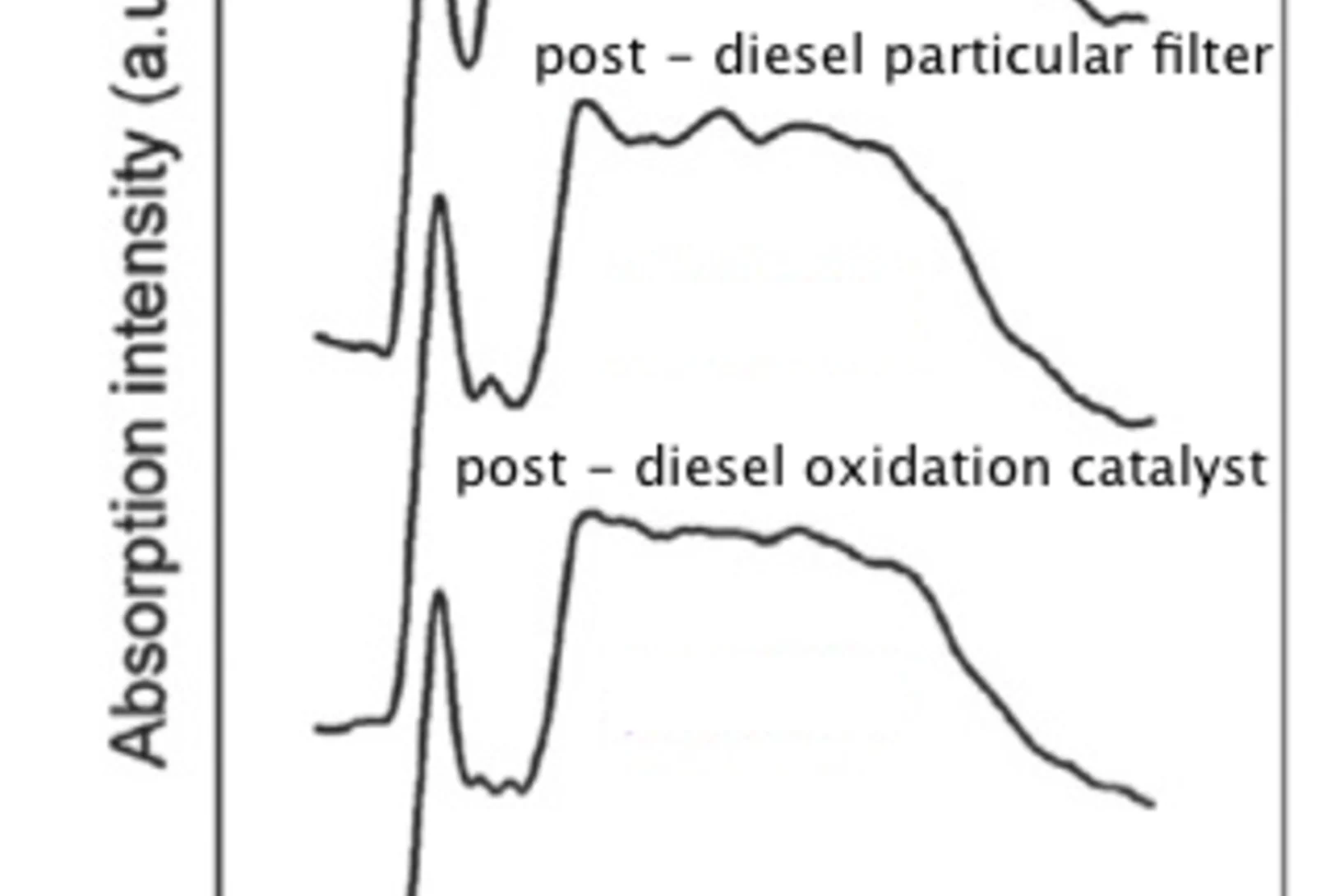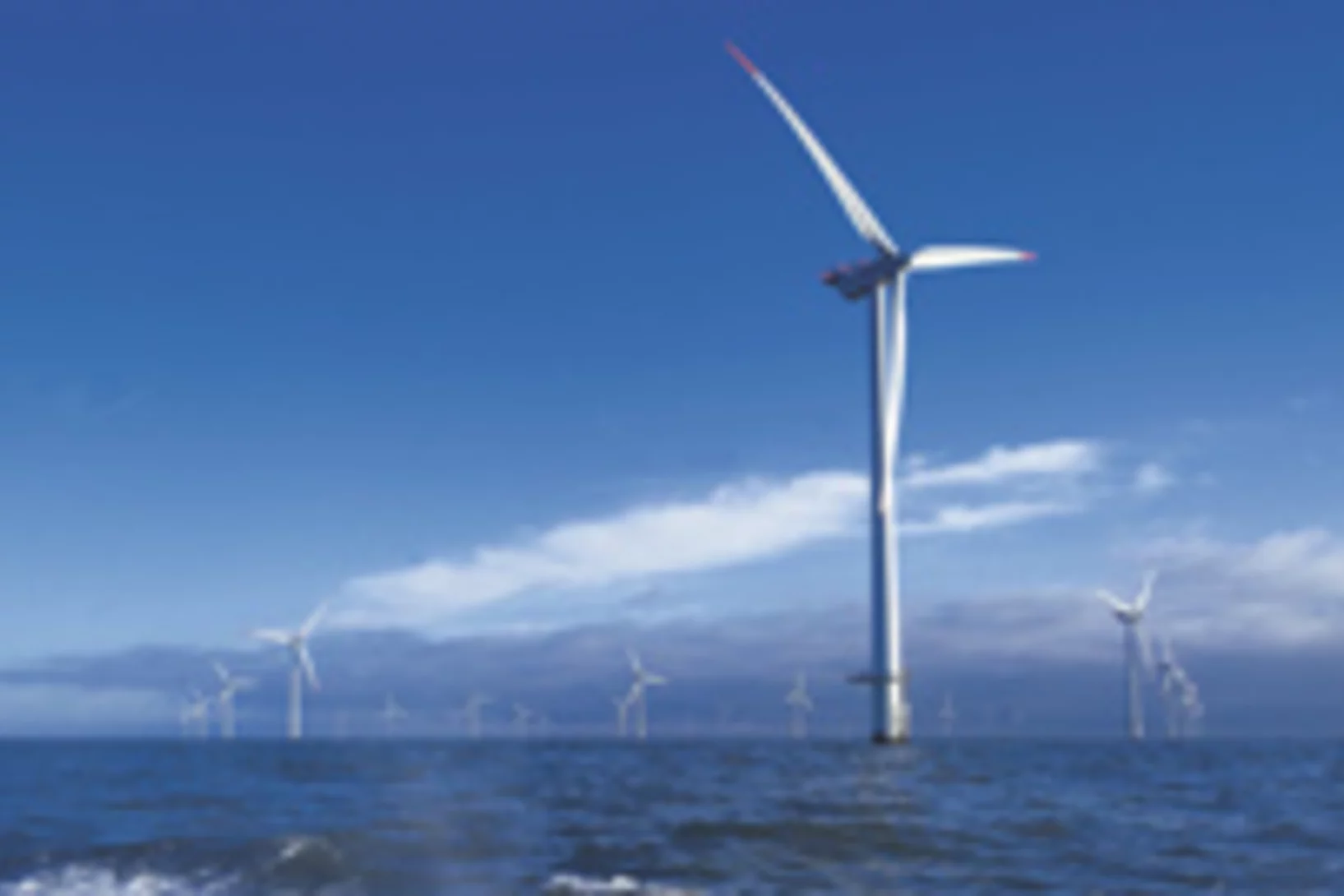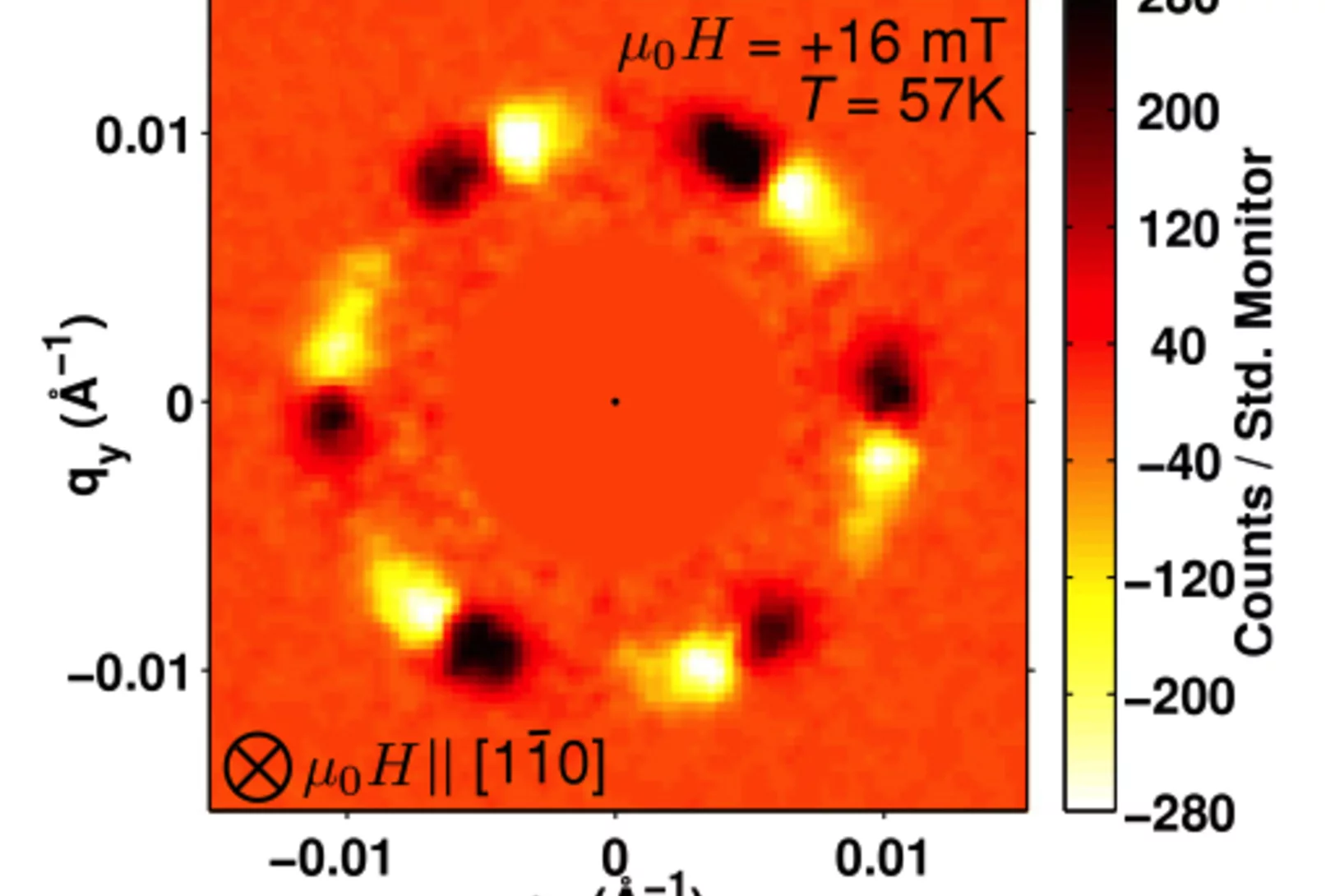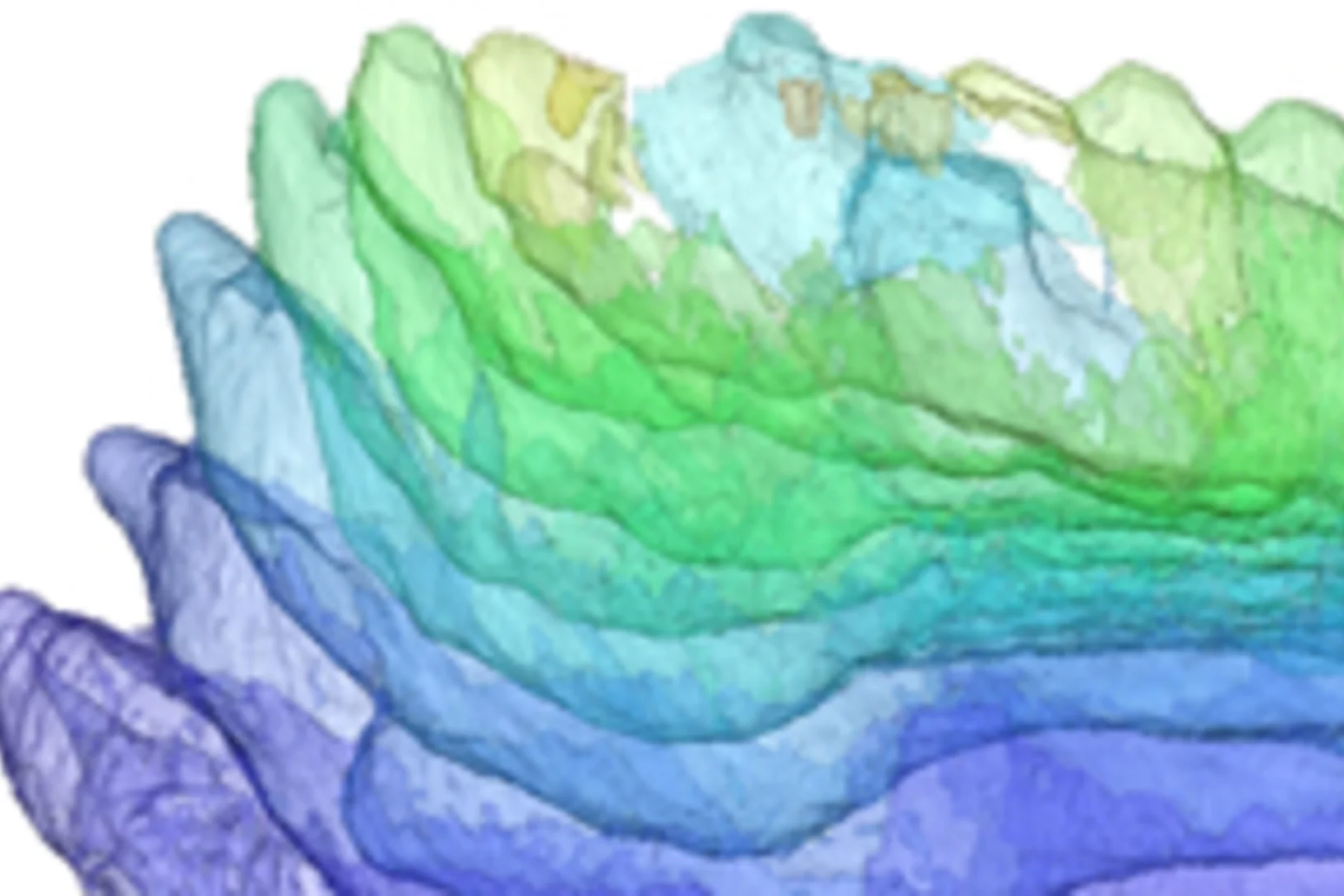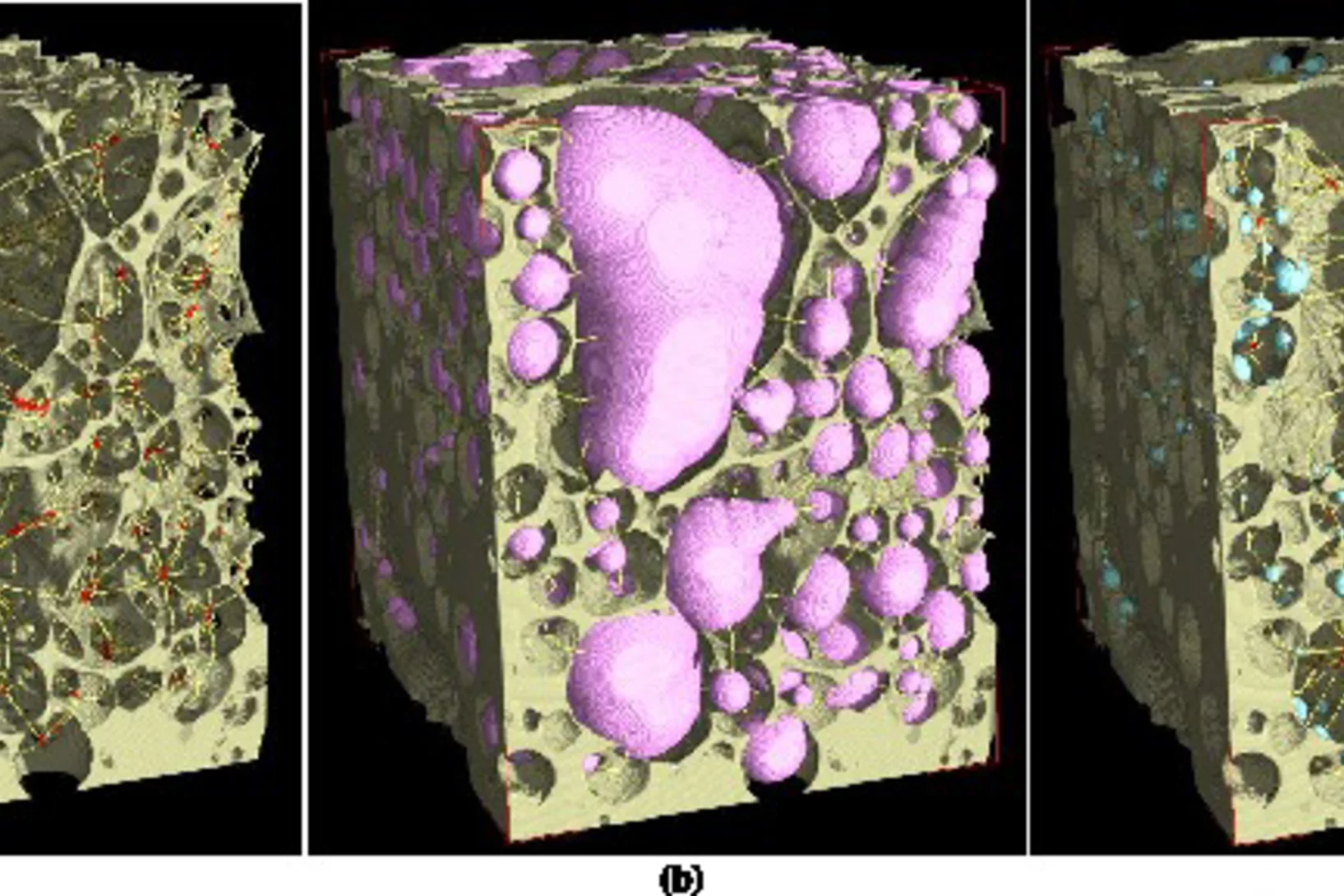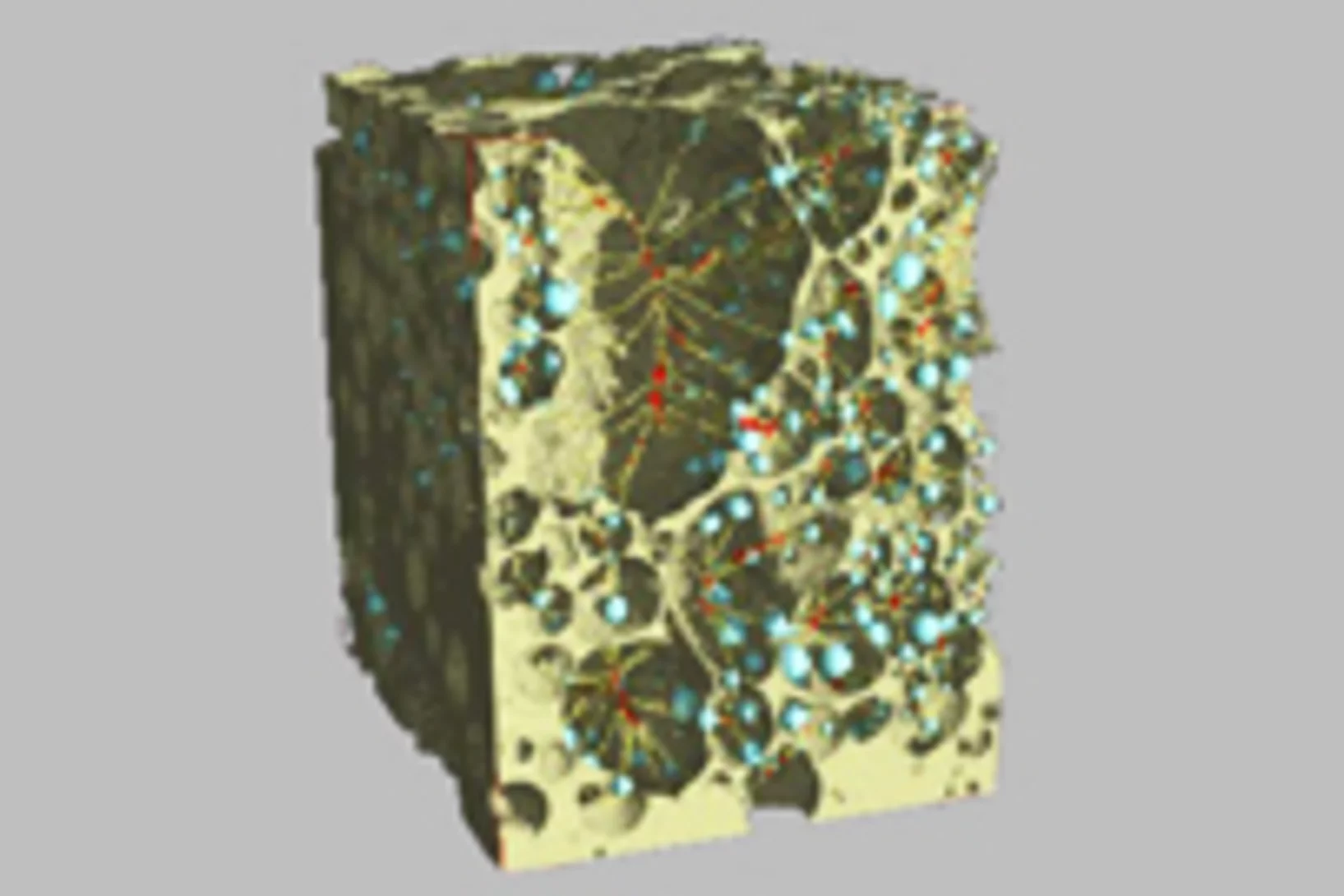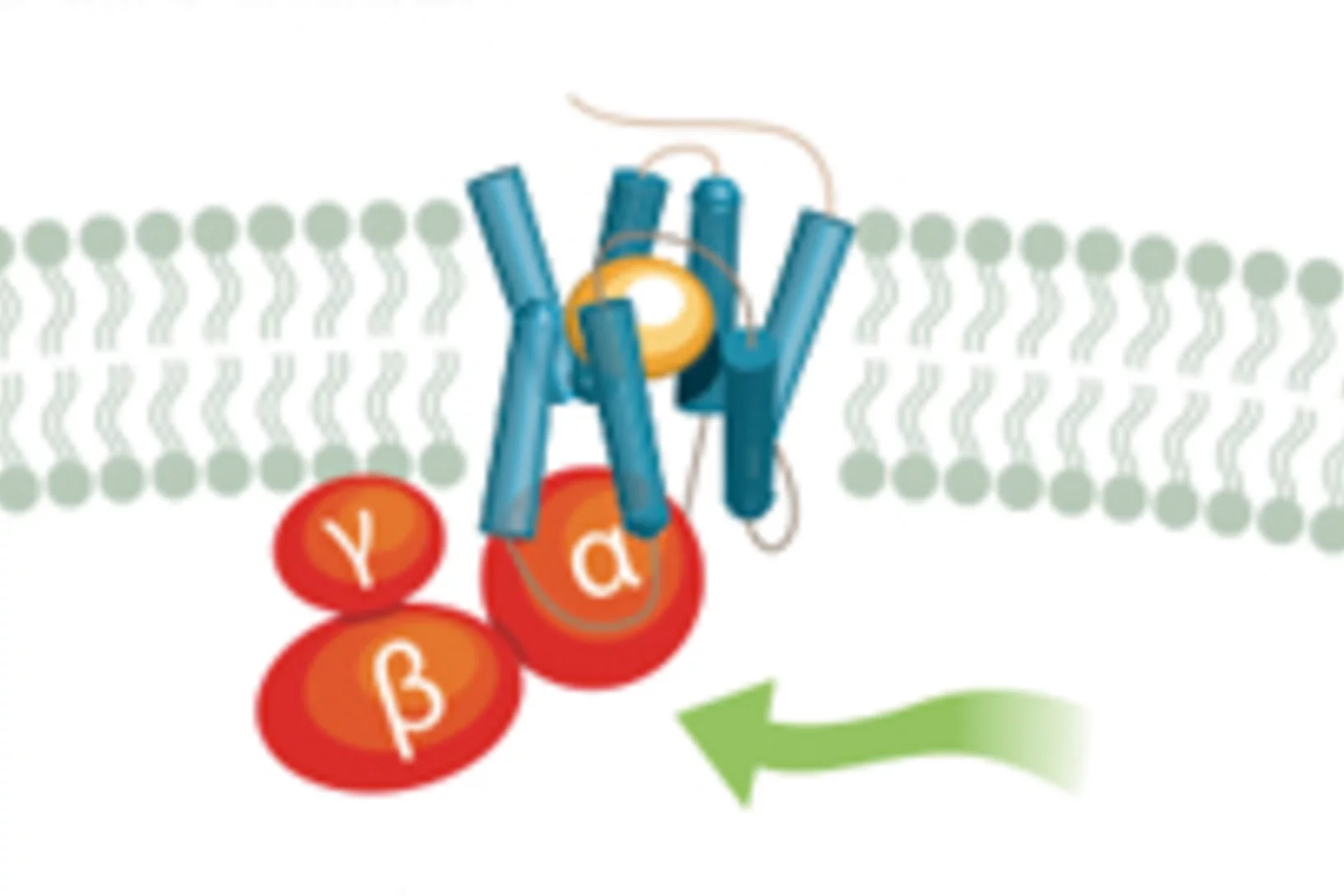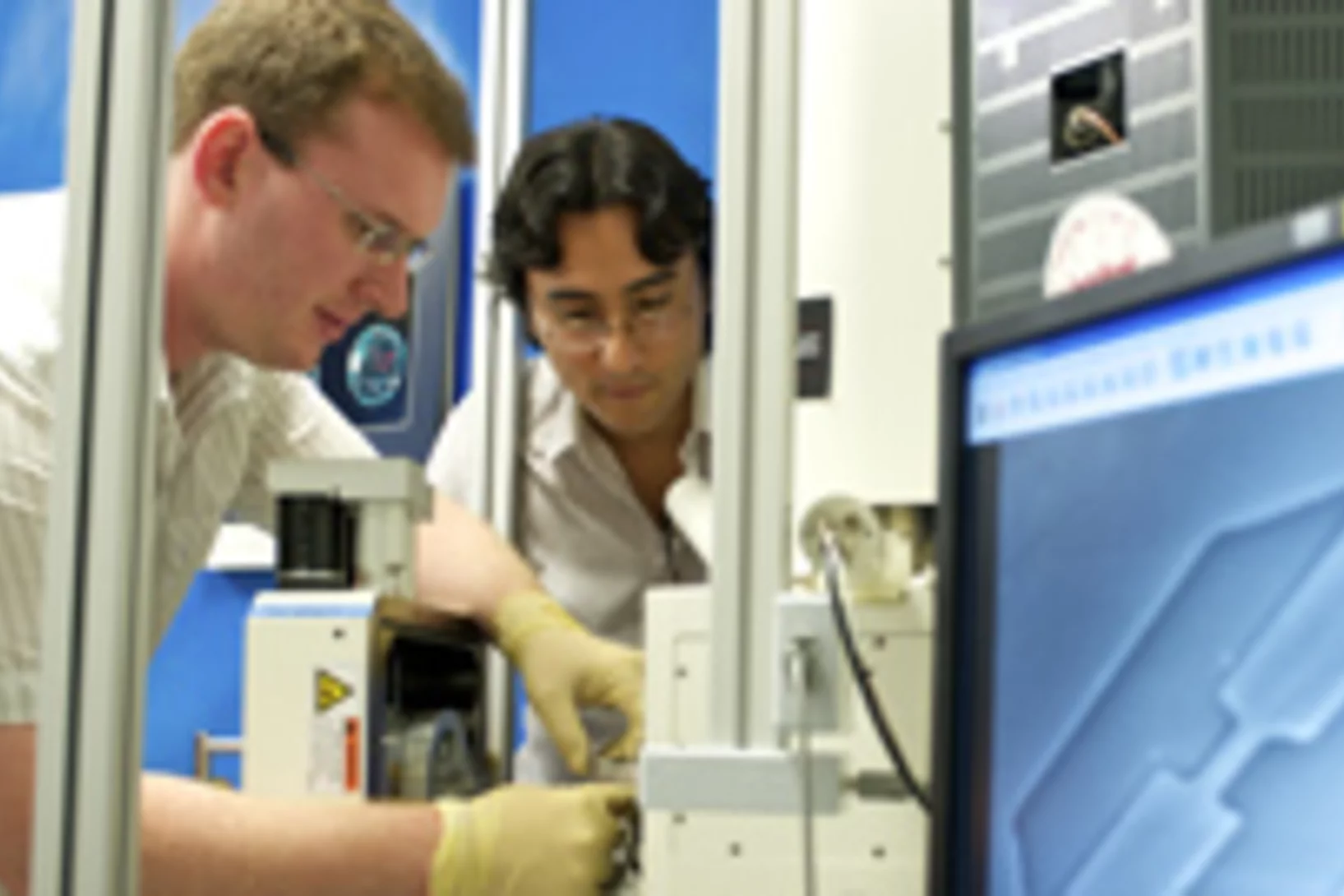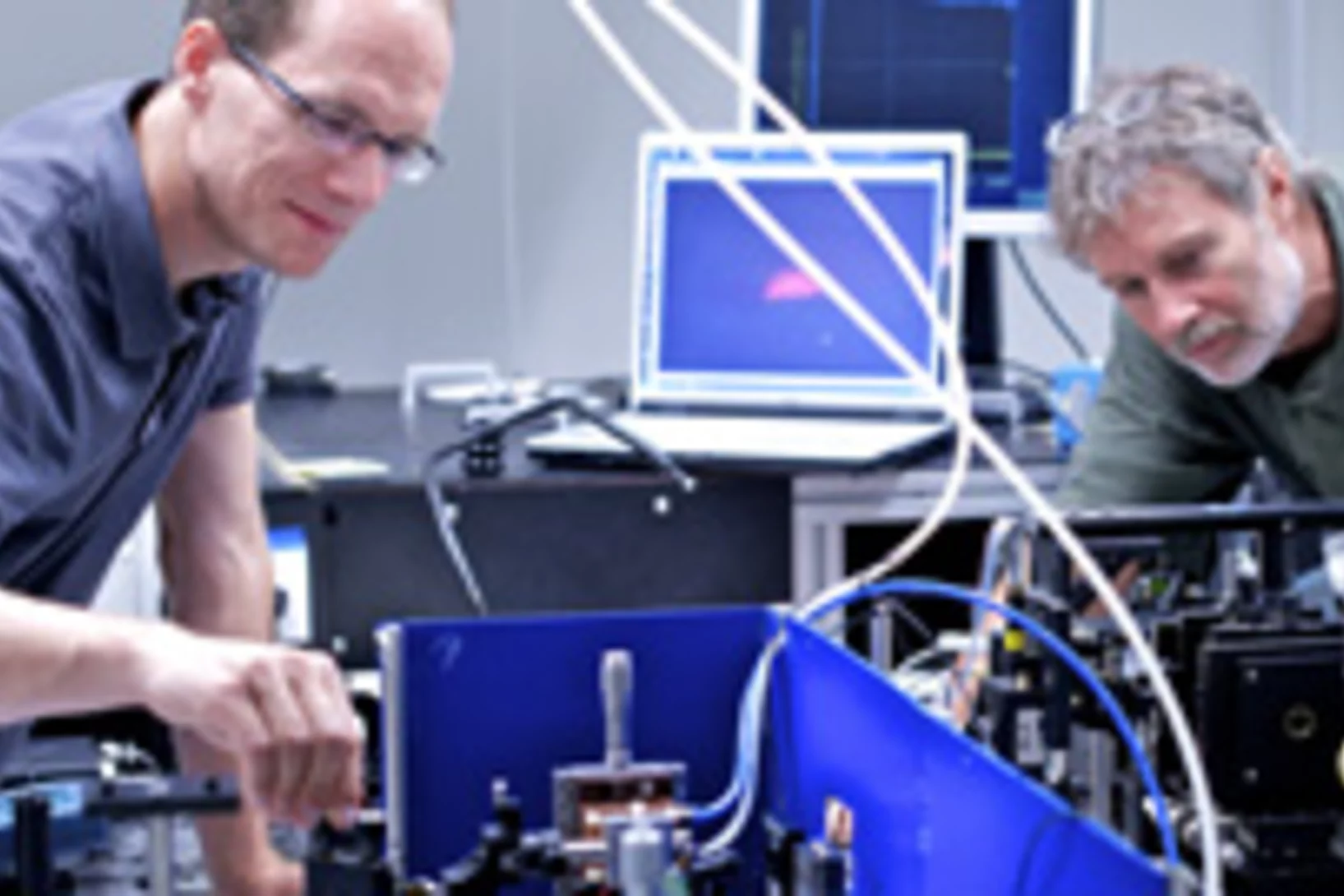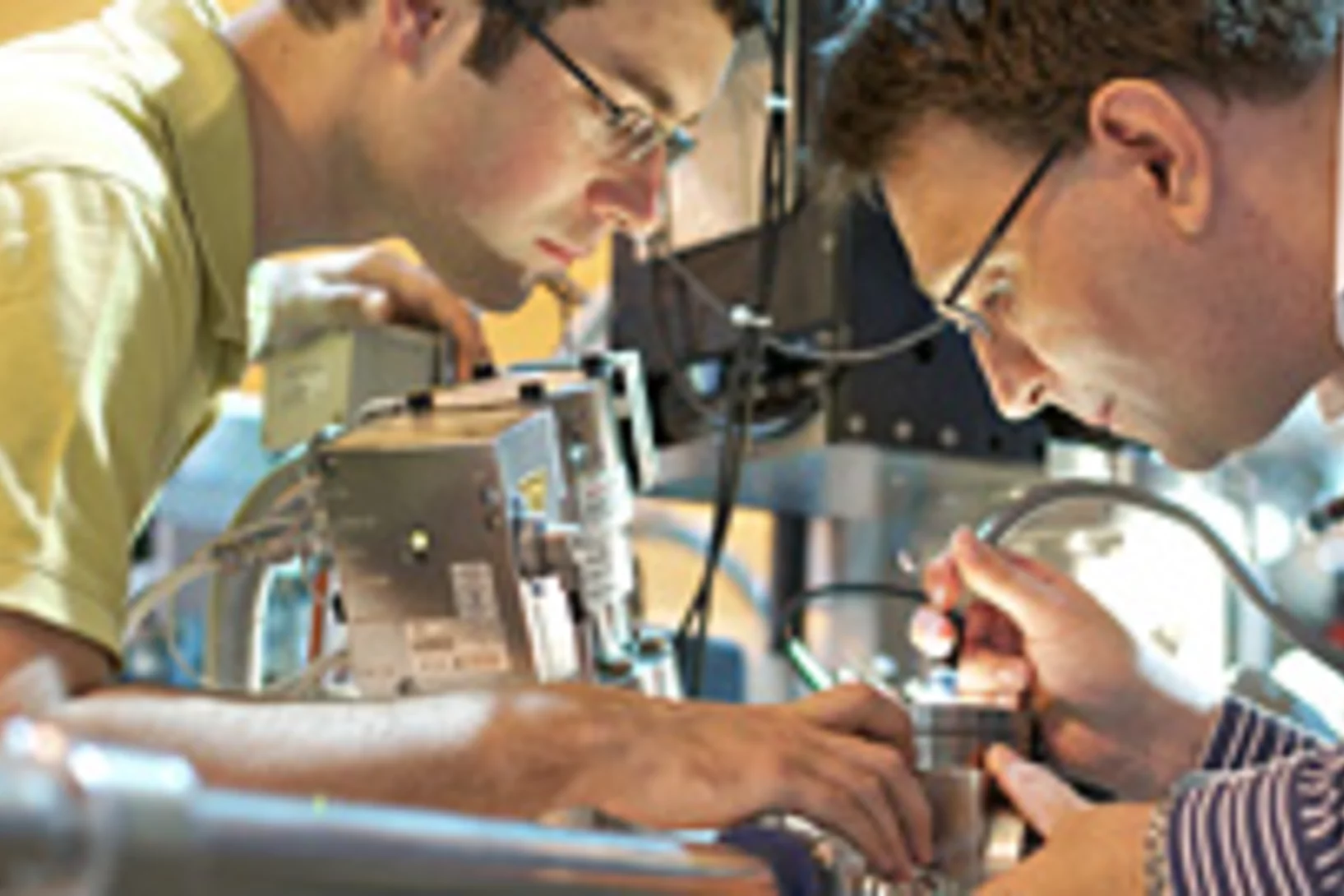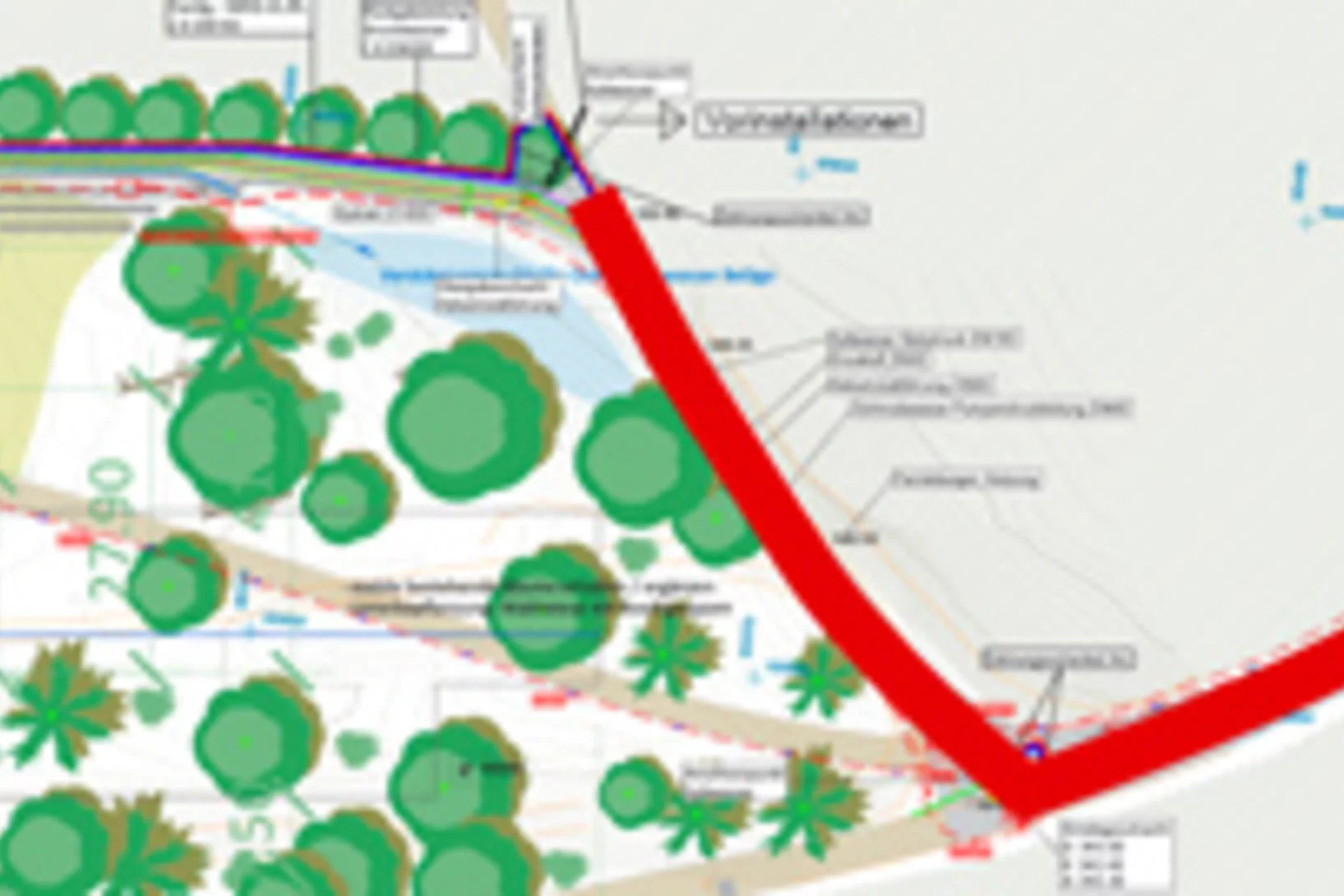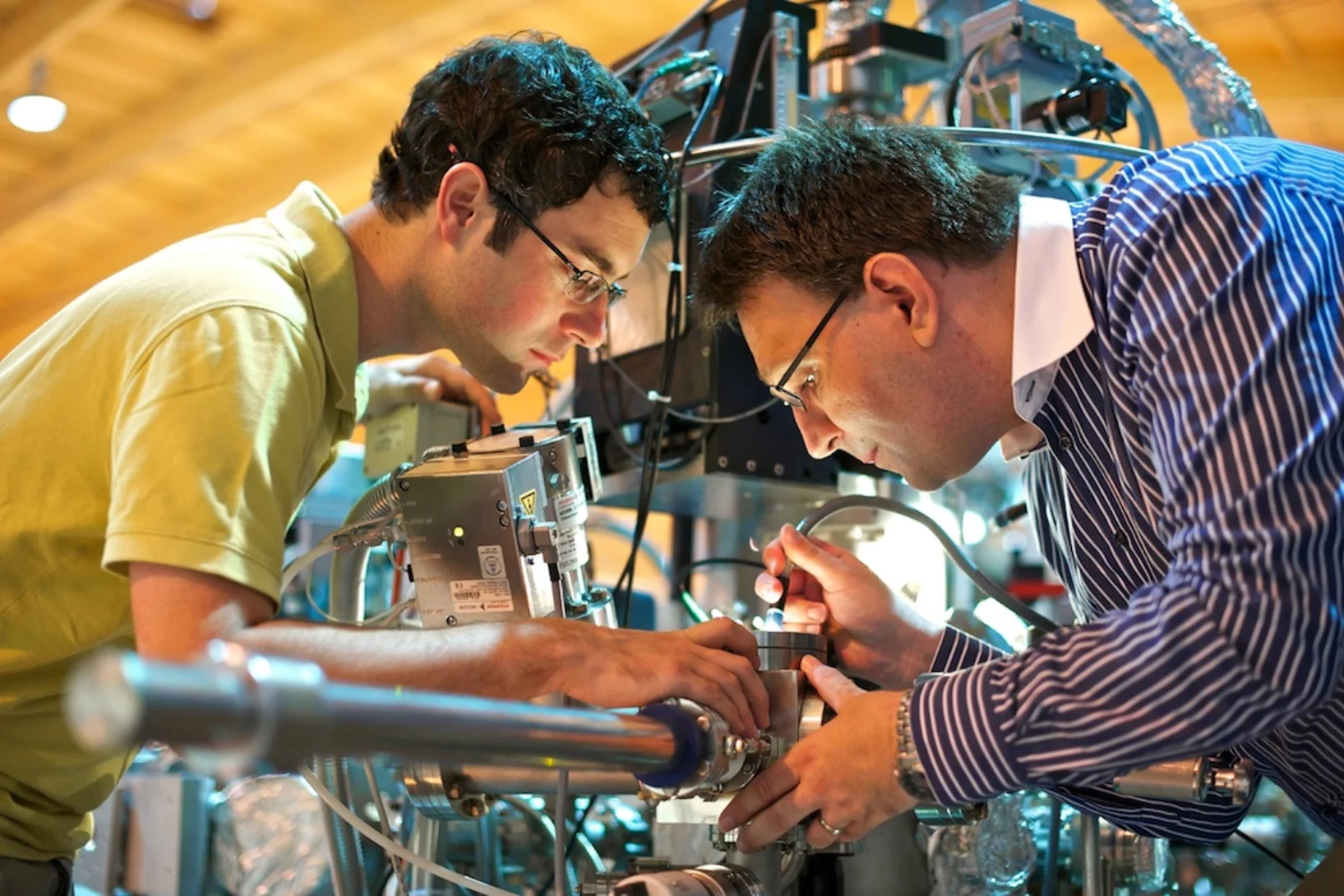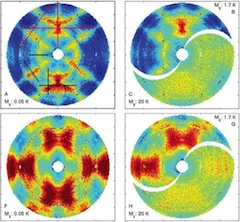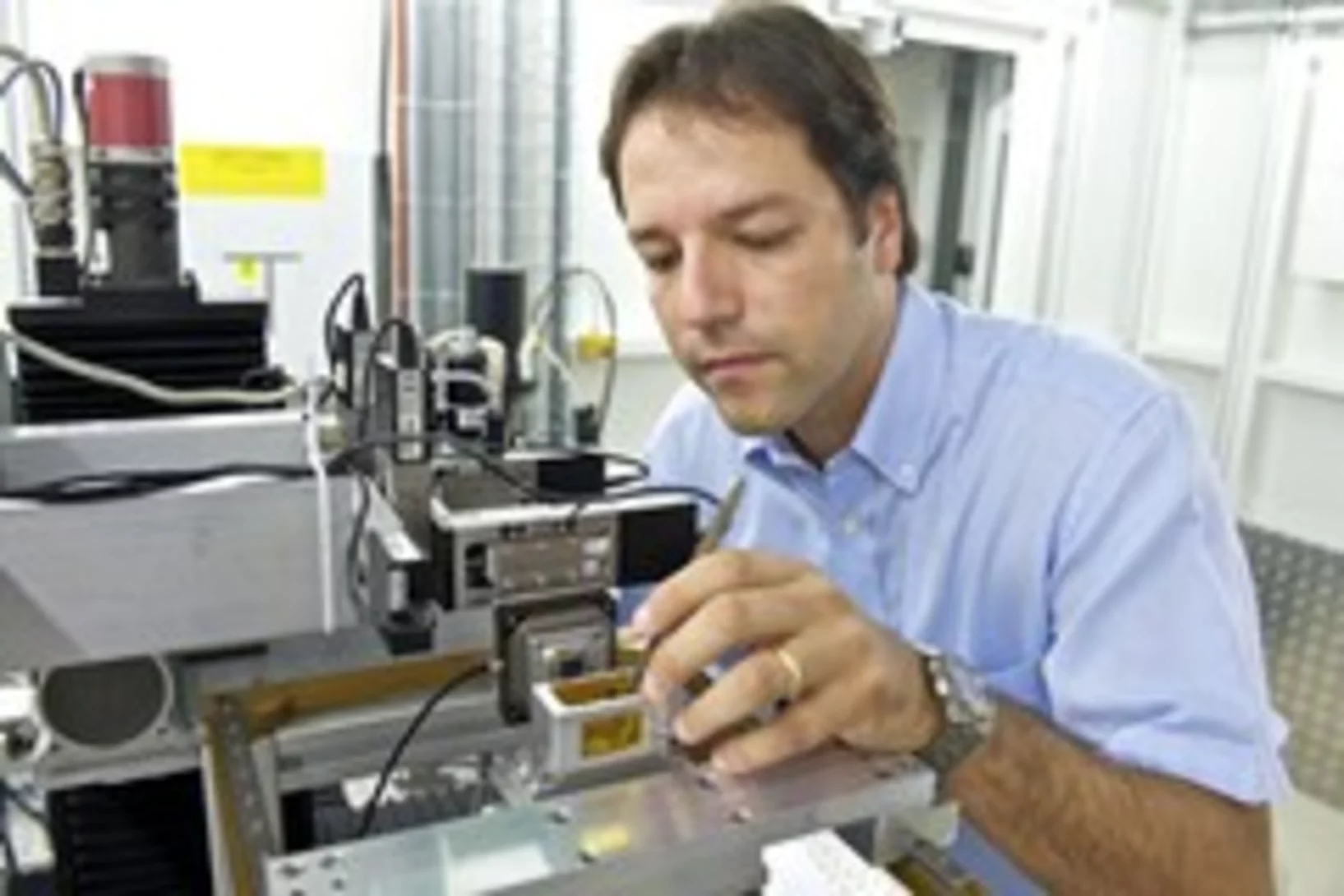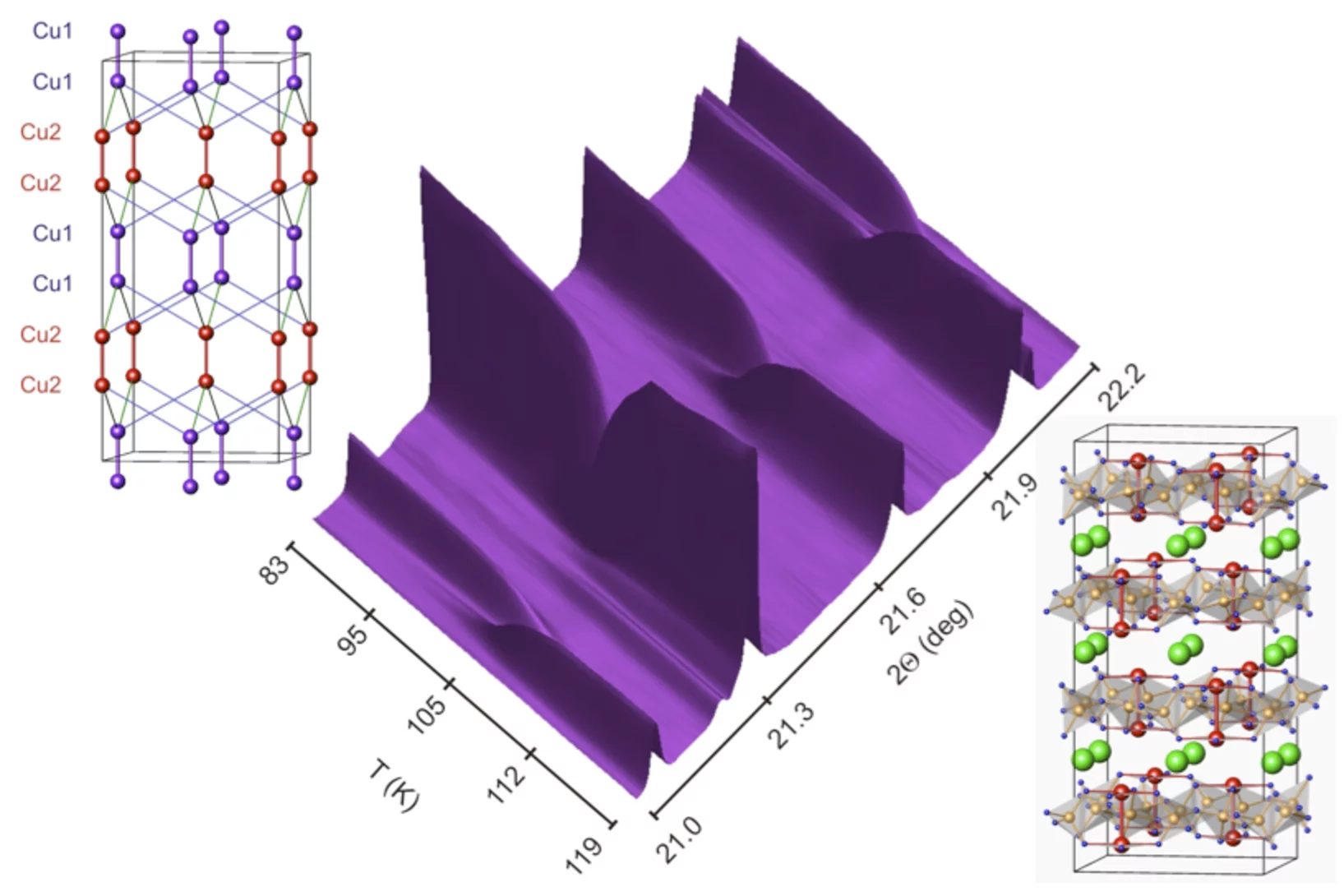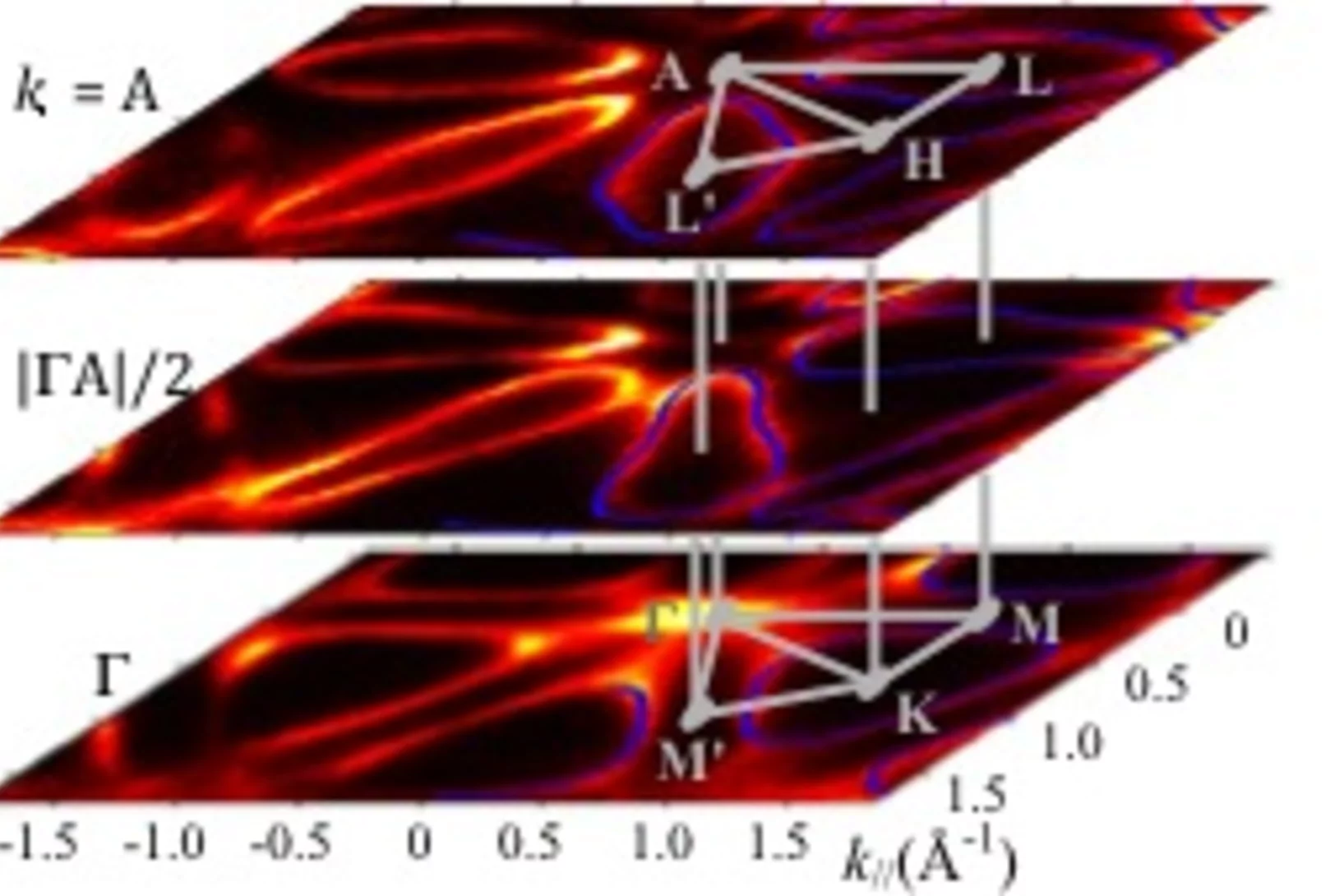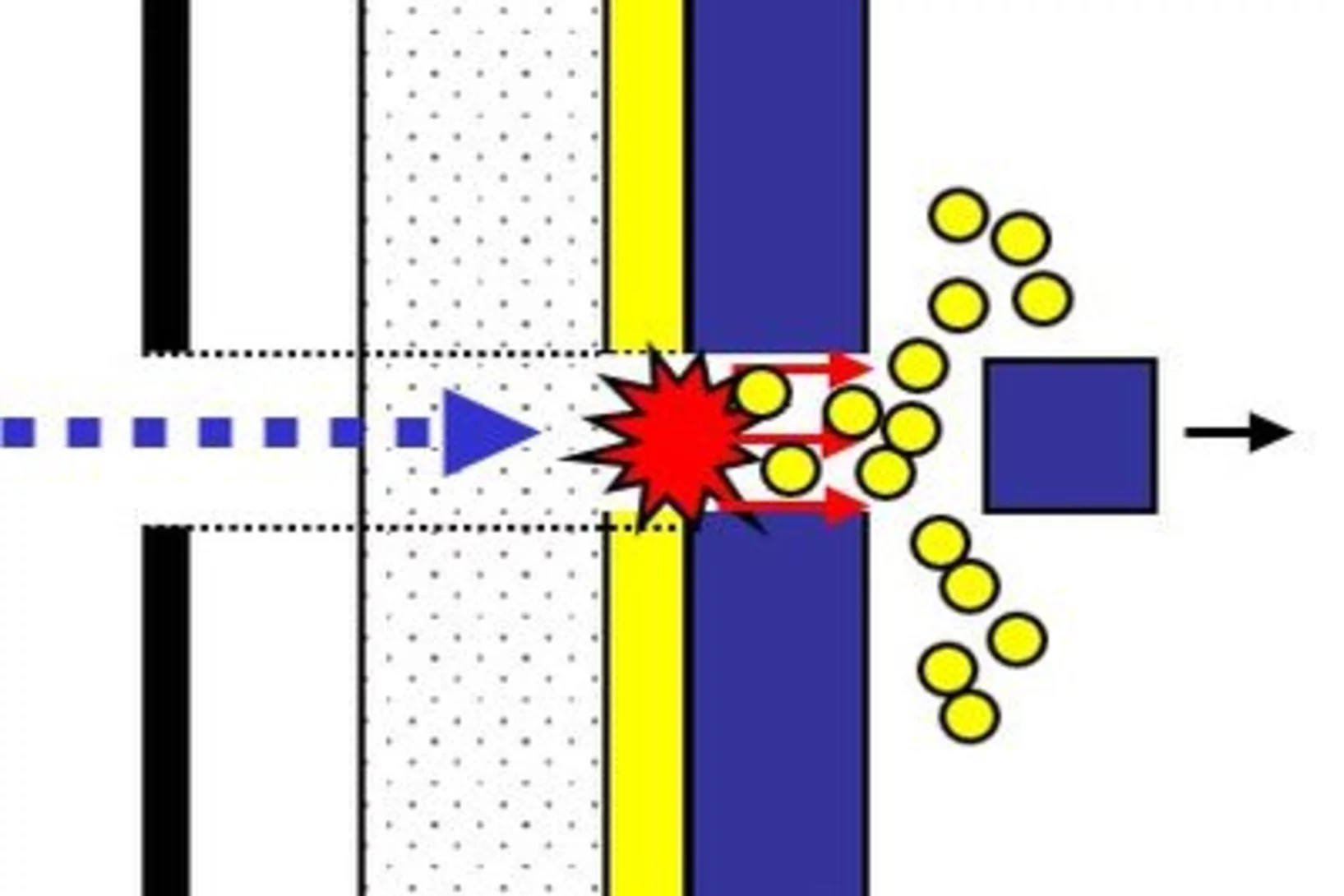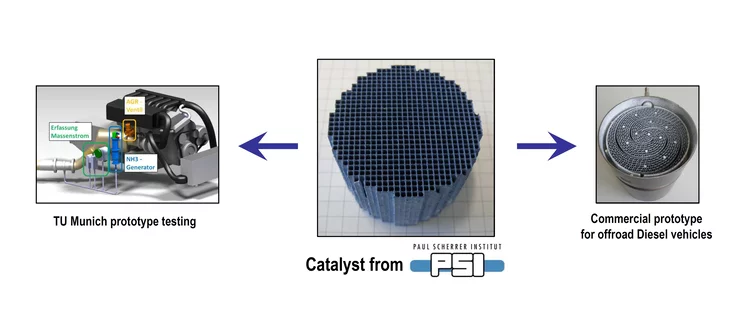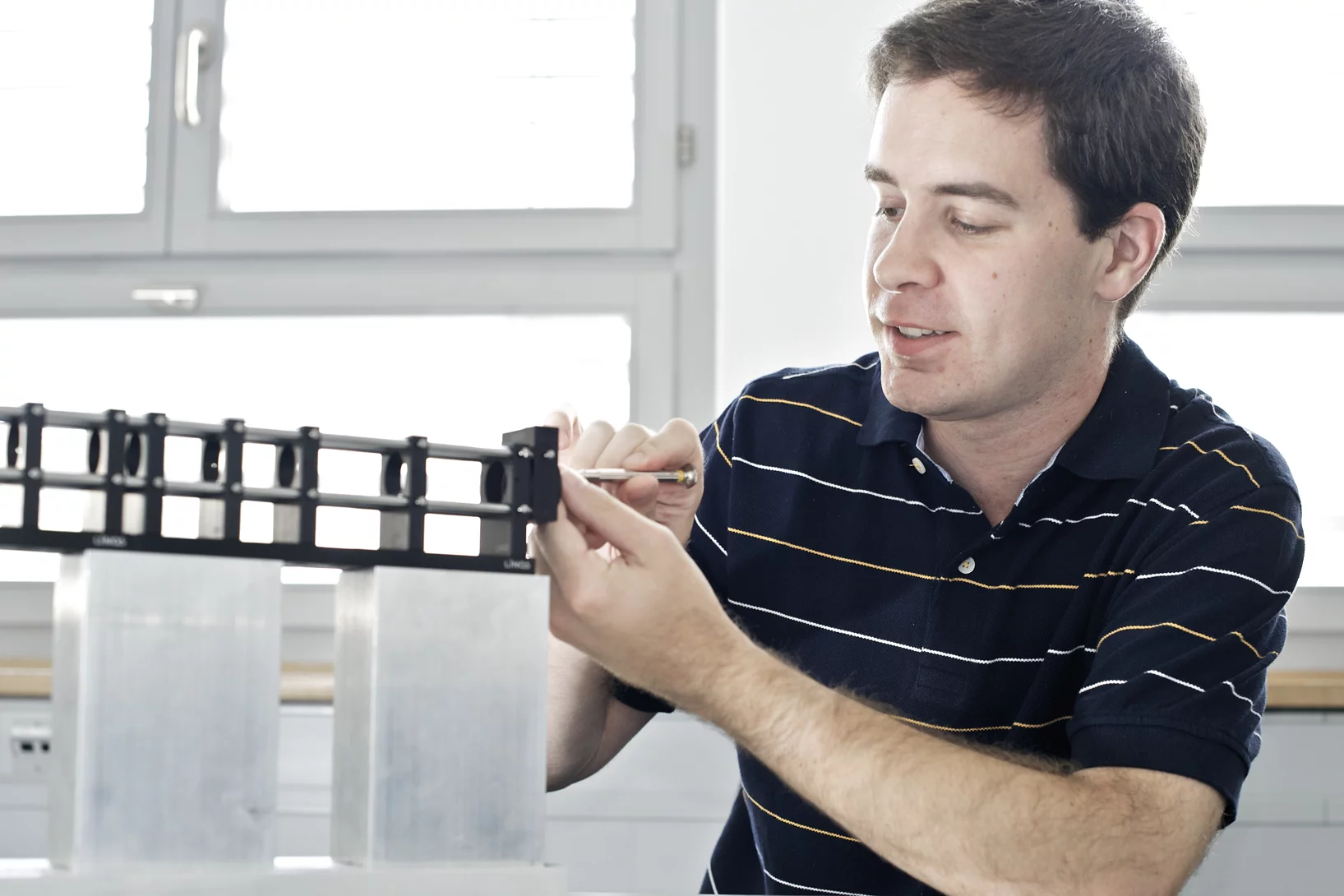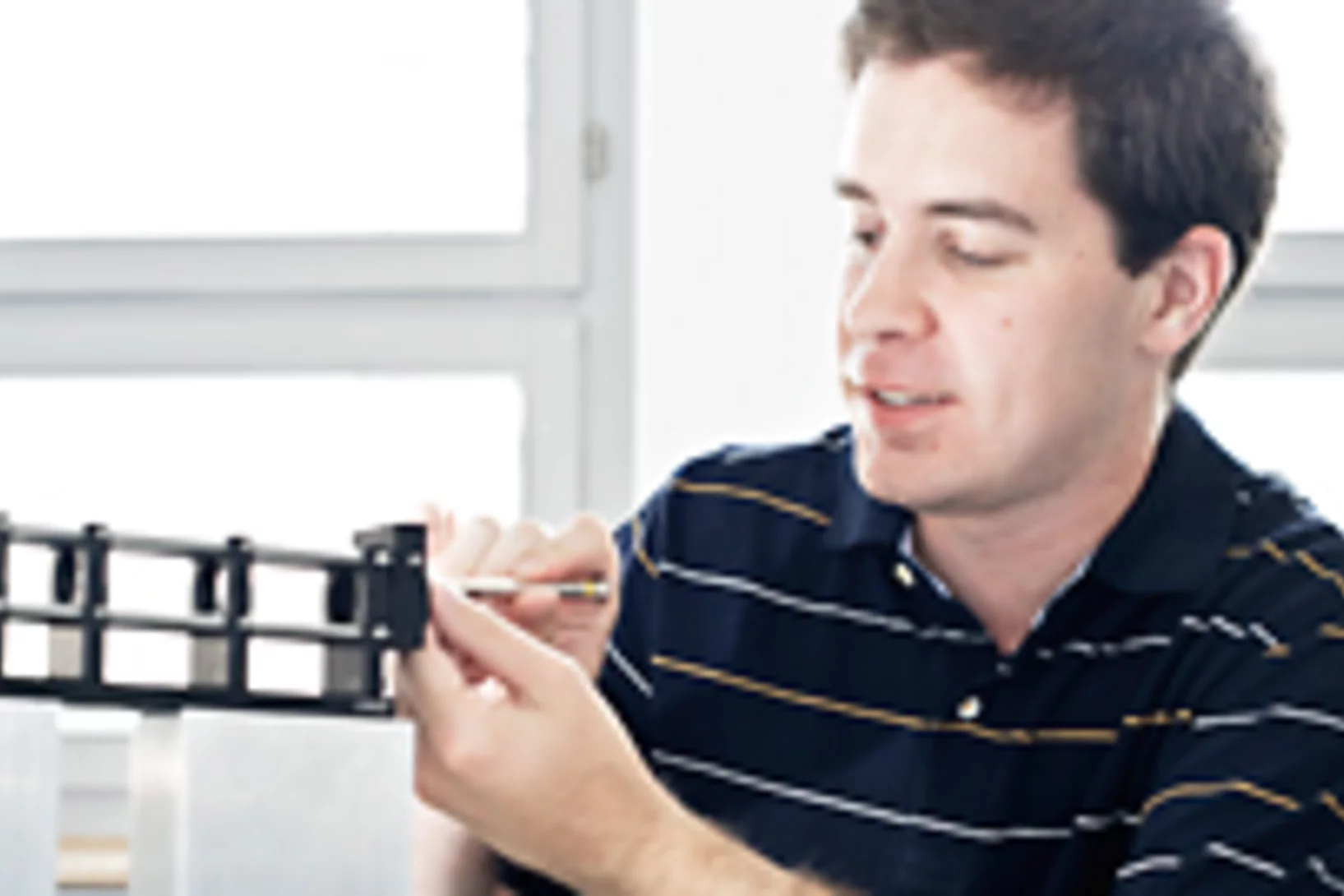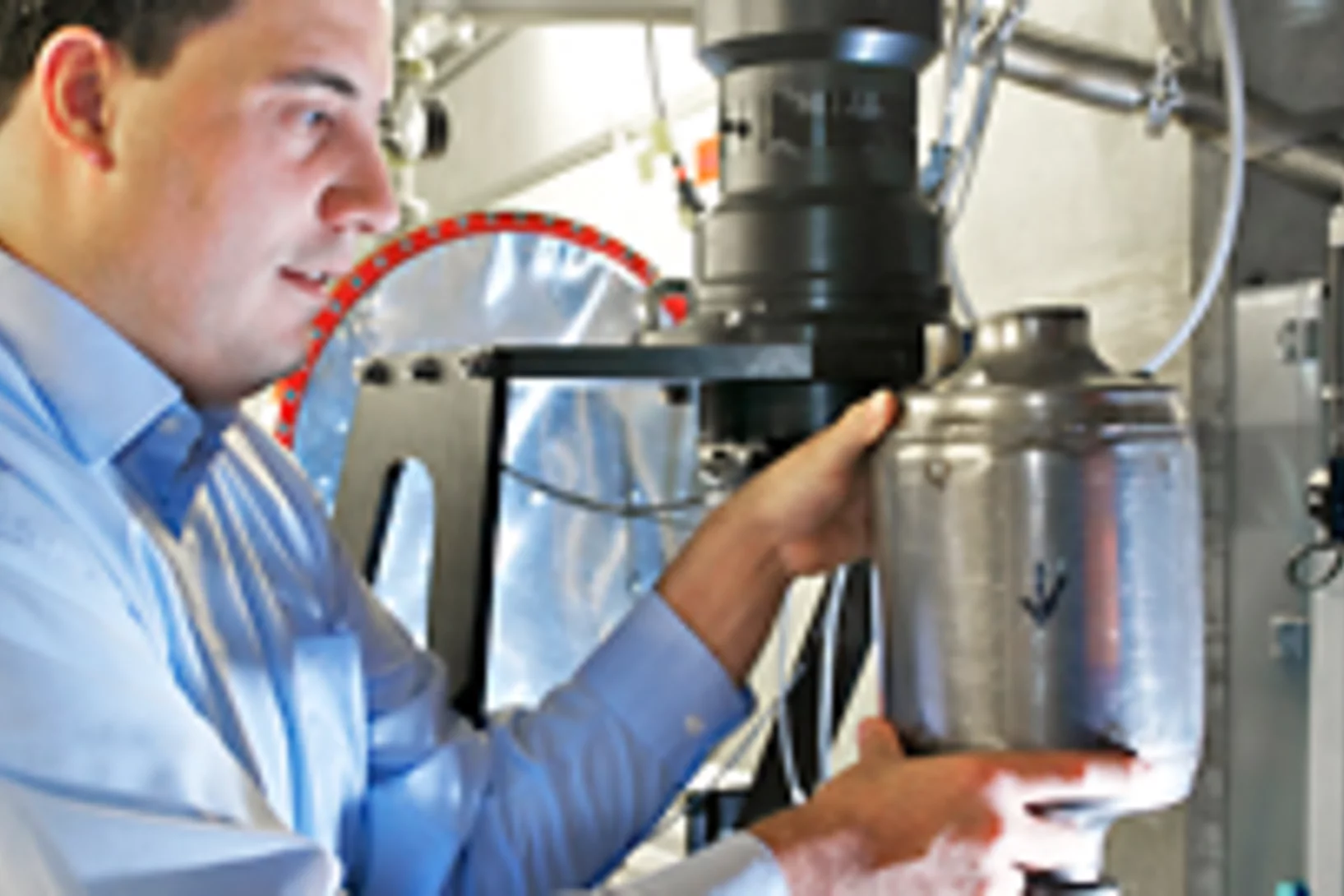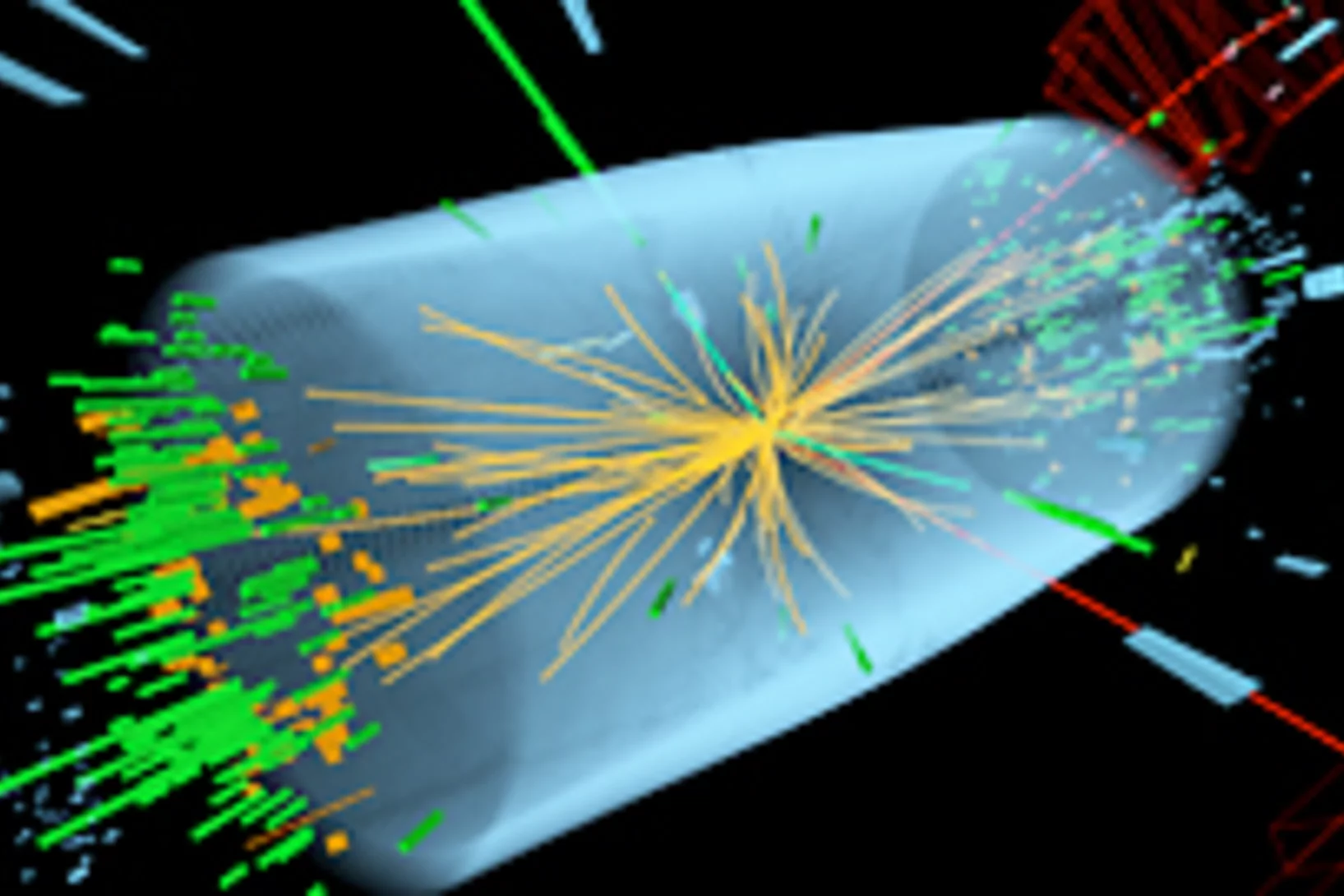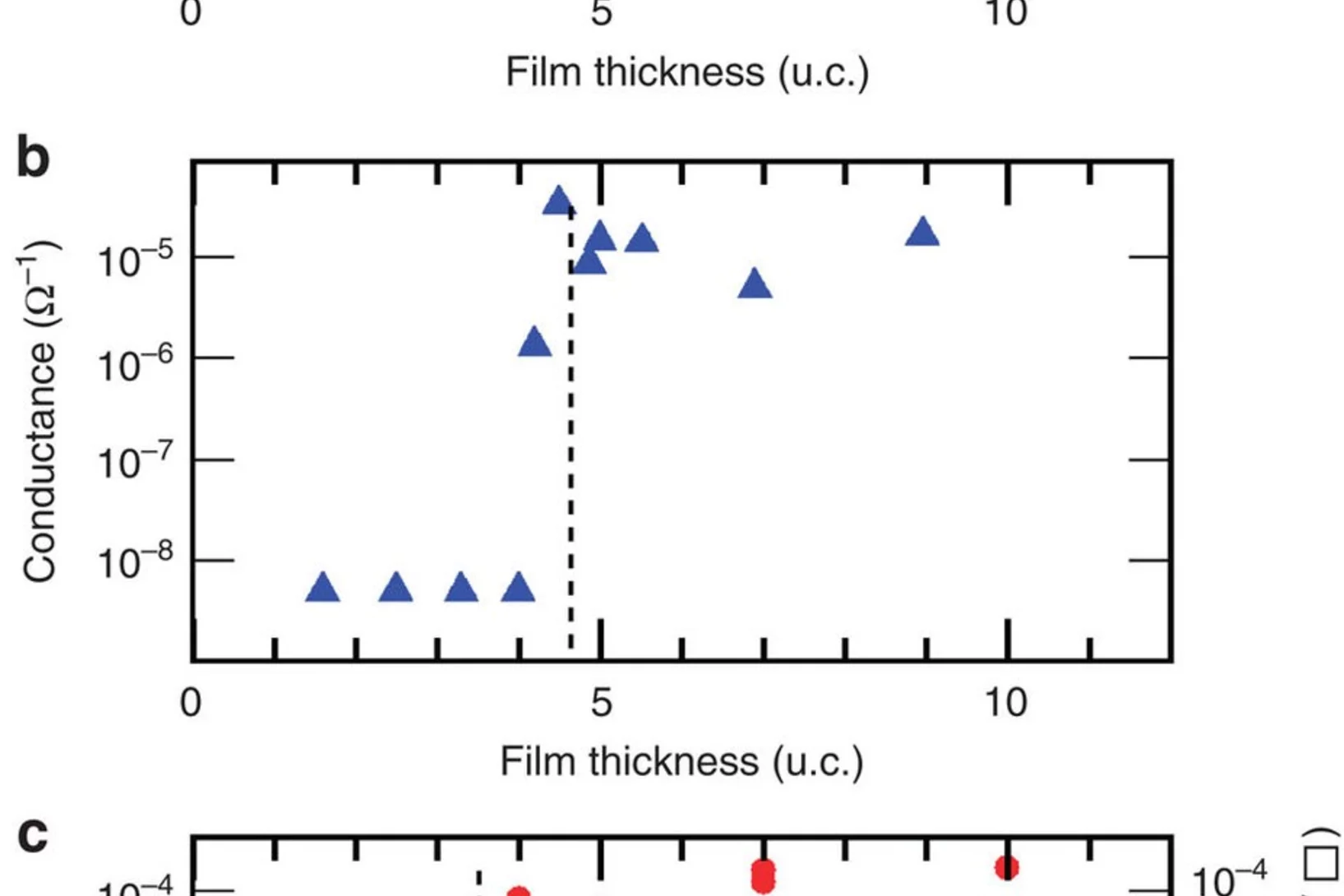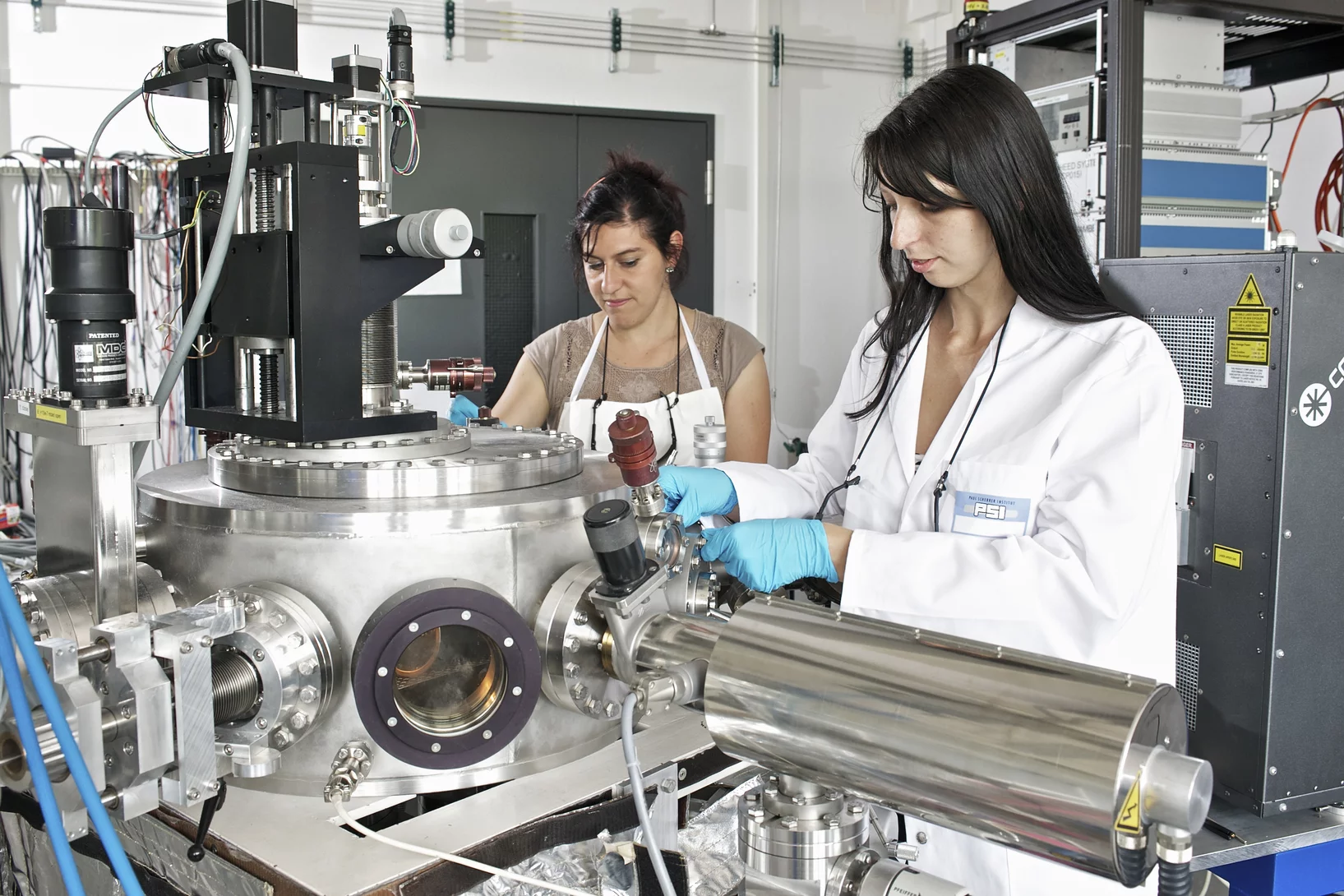Am Paul Scherrer Institut suchen Forschende nach Antworten auf die fundamentale Frage nach den Grundstrukturen der Materie und den fundamentalen Funktionsprinzipien in der Natur. Sie untersuchen Aufbau und Eigenschaften der Elementarteilchen – der kleinsten Bausteine der Materie – oder gehen der Frage nach, wie biologische Moleküle aufgebaut sind und wie sie ihre Funktion erfüllen. Das so gewonnene Wissen öffnet neue Lösungsansätze in Wissenschaft, Medizin oder Technologie.
Mehr dazu unter Überblick Grundlagen der Natur
Spin ladders and quantum simulators for Tomonaga-Luttinger liquids
Magnetic insulators have proven to be usable as quantum simulators for itinerant interacting quantum systems. In particular the compound (C5H12N)2CuBr4 (for short: (Hpip)2CuBr4) was shown to be a remarkable realization of a Tomonaga-Luttinger liquid (TLL) and allowed us to quantitatively test the TLL theory.
Stoffen bei der Umwandlung zusehen
Experimente am SwissFEL sollen helfen, genau zu verstehen, wie sich Stoffe in einer Reaktion ineinander umwandeln. Ein Schwerpunkt werden katalytische Reaktionen sein, die zahllose Anwendungen haben. Die Forschung wird Wege zu energiesparenden Industrieprozessen und umweltfreundlichen Energieträgern aufzeigen.
Die schwache Seite des Protons
Ein internationales Forschungsteam hat mit grosser Genauigkeit bestimmt, wie das Proton an der schwachen Wechselwirkung à einer der vier fundamentalen Kräfte der Natur à teilhat. Die Ergebnisse bestätigen die theoretischen Voraussagen des Standardmodells der Teilchenphysik. In dem Experiment wurde beobachtet, mit welcher Wahrscheinlichkeit Myonen von Protonen eingefangen werden à ein Prozess, der von der schwachen Wechselwirkung bestimmt wird. Das Experiment wurde am Paul Scherrer Institut PSI durchgeführt, dem einzigen Ort weltweit, an dem genügend Myonen zur Verfügung stehen.
Wie stabilisierte Zellfasern Krebszellen am Teilen hindern
Die unter dem Schlagwort Chemotherapie verwendeten Krebsmedikamente hindern Zellen daran sich zu teilen. Da sich die Zellen in einem wachsenden Tumor häufiger teilen als andere, werden Tumorzellen besonders stark geschädigt. Forscher des Paul Scherrer Instituts und der ETH Zürich haben nun für eine Klasse solcher Medikamente den genauen Wirkmechanismus aufgeklärt. Die gewonnenen Informationen sind so exakt, dass man nun gezielt Medikamente entwickeln könnte, die noch besser an ihre Aufgabe angepasst sind.
Variations in diesel soot reactivity along the exhaust after-treatment system, based on the morphology and nanostructure of primary soot particles
The reactivity of soot at different sites of the exhaust after-treatment system of a diesel engine (upstream and downstream of the diesel oxidation catalyst (DOC), downstream of the diesel particulate filter (DPF), as well as inside the DPF) was investigated on the basis of morphology and structure of primary soot particles by high resolution transmission electron microscopy (HRTEM). The results indicate that combustion-formed soot particles are susceptible to further transformations of their morphology within the exhaust system.
Persistent Spin Dynamics Intrinsic to Amplitude-Modulated Long-Range Magnetic Order
In geometrically and/or exchange frustrated materials spin fluctuations may endure down to lowest accessible temperatures - the phenomenon known as persistent spin dynamics. Since spin fluctuations hinder the onset of extended static correlations, persistent spin dynamics and long-range magnetic order are generally considered as mutually exclusive. Remarkably, their coexistence has been found in several frustrated magnetic systems but was lacking a suitable explanation.
Die neue Schweizer Energiepolitik: Woher kommt der Strom?
Der neue Energie-Spiegel ist da.Mit der neuen Energiepolitik kommen grosse Veränderungen auf die Schweizer Stromversorgung zu. Werden erneuerbare Energiequellen genug Strom produzieren, um nach dem Aus der Kernkraftwerke unseren Verbrauch zu decken? Oder müssen wir uns in Zukunft auf Gaskraftwerke und Stromimporte verlassen? Und wie wirkt sich die neue Energiepolitik auf die CO2-Bilanz und die Stromkosten aus? Diese Fragen versucht die neueste Ausgabe des Energie-Spiegels zu beantworten.
Electric field control of the skyrmion lattice in Cu2OSeO3
Skyrmions are topologically protected magnetic spin 'whirls' that form a hexagonal 2D lattice in non-centrosymmetric magnets. Until recently, skyrmions had only been observed in itinerant metallic alloys such as MnSi, where they can also be manipulated by applied electric currents.
Der evolutionäre Ursprung unserer Zähne
Bislang war umstritten ob die frühesten Wirbeltiere, die Kiefer hatten, schon Zähne besassen oder nicht. Nun hat ein international zusammengesetztes Forschungsteam gezeigt, dass der urzeitliche Fisch Compagopiscis bereits Zähne hatte. Das deutet darauf hin, dass Zähne in der Evolution gemeinsam mit den Kiefern entstanden sind à oder zumindest kurz danach. Federführend bei dem Projekt waren Forscher der Universität Bristol (England), die entscheidenden Untersuchungen sind an der SLS durchgeführt worden.
X-rays provide insights into volcanic processes
Experiments performed at the Paul Scherrer Institute (PSI) investigate processes inside volcanic materials that determine whether a volcano will erupt violently or mildly.
Röntgenlicht liefert Einblicke in die Ursachen von Vulkanausbrüchen
Experimente am Paul Scherrer Institut bieten Einblicke in Vorgänge in vulkanischen Materialien, die darüber entscheiden wie heftig ein Vulkan ausbricht. Dabei haben Forschende ein Stück vulkanisches Material so aufgeheizt, dass darin Bedingungen entstanden, wie sie am Beginn eines Vulkanausbruchs herrschen. Sie nutzten dann Röntgenlicht aus der SLS, um in Echtzeit zu verfolgen, was in dem Gestein passiert, während es schmilzt.
Nobelpreiswürdig: G-Protein-gekoppelte Rezeptoren
Der Nobelpreis für Chemie geht in diesem Jahr an Robert J. Lefkowitz und Brian K. Kobilka. Sie haben herausgefunden, wie eine Familie von Rezeptoren funktioniert, die man G-Protein-gekoppelte Rezeptoren (GPCR) nennt. Auch am PSI leisten Wissenschaftler Beiträge auf diesem Forschungsgebiet.
Silizium – fast zum Zerreissen verspannt
Zieht man ein Stück Silizium auseinander, erzeugt man in dessen Inneren eine mechanische Spannung, die die elektronischen Eigenschaften des Materials deutlich verbessern kann. Forscher des Paul Scherrer Instituts und der ETH Zürich haben mit einem neuen Verfahren in einer Siliziumschicht extrem verspannte Nanodrähte erzeugt. Für ein Material, das als Grundlage für Elektronikbauteile dienen kann, wurde dabei die bislang höchste mechanische Spannung gemessen. Ziel ist es, auf Basis solcher Drähte leistungsfähige Transistoren für Mikroprozessoren herzustellen.
Eingebaute Germanium-Laser könnten Computer-Chips schneller machen
Forscher des Paul Scherrer Instituts haben untersucht, wie man das Halbleitermaterial Germanium dazu bringen könnte, Laserlicht auszusenden. Als Lasermaterial könnte Germanium mit Silizium die Grundlage für neuartige Computerchips bilden, in denen Informationen zum Teil in Form von Licht übertragen würden. Diese Technologie würde es ermöglichen, den Datenfluss auf Chips zu revolutionieren und so die Leistung der Elektronik weiter voranzutreiben.
Neue Einblicke in Supraleitermaterialien
Eine neue Röntgenmethode erlaubt Einblicke in die magnetischen Eigenschaften einzelner Atomlagen eines Materials, das die Grundlage einiger Hochtemperatursupraleiter bildet. Dabei zeigte sich, dass sich die atomar dünnen Materialschichten in den magnetischen Eigenschaften erstaunlich wenig von makroskopisch dicken Materialproben unterscheiden. In Zukunft könnte man so Vorgänge in sehr dünnen Supraleitermaterialien erforschen und zum Verständnis des Phänomens der Hochtemperatursupraleitung beitragen.
Erschliessungsarbeiten für den SwissFEL starten
Am 3. September 2012 starten die Erschliessungsarbeiten zur neuen Grossforschungsanlage SwissFEL des Paul Scherrer Instituts. Mit ihnen wird die für den SwissFEL notwendige Anbindung an die vorhandene PSI-Infrastruktur hergestellt.
New Insights into Superconducting Materials
An American-Swiss research team has used a new X-ray technique at Swiss Light Source (SLS) of the Paul Scherrer Institute (PSI) to investigate the magnetic properties of atomically thin layers of a parent compound of a high-temperature superconductor. It turns out that the magnetic properties of such thin films differ by only a surprisingly small degree from those of macroscopically thick samples.
Power-Law Spin Correlations in the Pyrochlore Antiferromagnet Tb2Ti2O7
Spin correlations with power-law decay are usually associated with a critical point, but stable phases with power-law correlations may exist in frustrated magnets. Such phases are interesting, because they represent model materials where short-range interactions and local constraints lead to emergent symmetries and fractional quasiparticles.
ERC Grant for the development of a new imaging method with high potential clinical impact
Marco Stampanoni, Assistant Professor for X-ray microscopy at the ETH Zürich and Head of the 'X-ray Tomography Group' of the SLS has been recently awarded one of the coveted European Research Council (ERC) Starting Grant for the project PhaseX: 'Phase contrast X-ray imaging for medicine'. Marco Stampanoni's project will be supported by the ERC with 1.5 million euros for the next 5 years. The highly competitive ERC Starting Grants are reserved for outstanding young research talents.
Two types of adjacent dimer layers in the low temperature phase of BaCuSi2O6
The interest in BaCuSi2O6 is motivated by its extraordinary phase diagram with field-induced Bose-Einstein condensation. Being a quantum paramagnet at zero magnetic field down to the lowest temperatures, the system displays a quantum phase transition into a magnetically ordered state at the critical value of magnetic field of ~23.5 T.
Three-Dimensional Electron Realm in Crystalline Solids Revealed with Soft-X-Rays
The electronic band structure E(k) as energy E of the electrons depending on its wavevector k is the cornerstone concept of the quantum solid state theory. The main experimental method to investigate E(k) is the angle-resolved photoelectron spectroscopy (ARPES). However, a small photoelectron escape depth of a few Å largely restricts the applications of ARPES to two-dimensonal crystals.
Laser-Induced Forward Transfer for the Fabrication of Devices
In conjunction with the increasing availability of cost-efficient laser units during the recent years, laser-based micromachining techniques have been developed as an indispensable industrial instrument of ‘‘tool-free’’ high-precision manufacturing techniques for the production of miniaturized devices made of nearly every type of materials. Laser cutting and drilling, as well as surface etching, have grown meanwhile to mature standard methods in laser micromachining applications where a well-defined laser beam is used to remove material by laser ablation. As an accurately triggerable nonmechanical tool, the ablating laser beam directly allows a subtractive direct-write engraving of precise microscopic structure patterns on surfaces, such as microchannels, grooves, and well arrays, as well as for security features. Therefore, laser direct-write (LDW) techniques imply originally a controlled material ablation to create a patterned surface with spatially resolved three-dimensional structures, and gained importance as an alternative to complementary photolithographic wet-etch processes. However, with more extended setups, LDW techniques can also be utilized to deposit laterally resolved micropatterns on surfaces, which allows, in a general sense, for the laser-assisted ‘‘printing’’ of materials.
Supported gold as catalyst for the decomposition of ammonia precursors in the selective catalytic reduction of NOx
Titanium dioxide-supported gold was found to catalyze the hydrolysis of formate-based ammonia precursor compounds which are proposed for the selective catalytic reduction of nitrogen oxides (NOx) in combustion exhaust gas. In contrast to other noble metals, the supported gold does not oxidize the released NH3, while it maintains decomposition of intermediate formic acid.
Supported gold as catalyst for the decomposition of ammonia precursors in the selective catalytic reduction of NOx
Titaniumdioxide supported gold was found to catalyze the hydrolysis of formate-based ammonia precursor compounds which are proposed for the selective catalytic reduction of nitrogen oxides (NOx) in combustion exhaust gas. In contrast to other noble metals, the supported gold does not oxidize the released NH3, while it maintains decomposition of intermediate formic acid.
Ultra-short X-ray laser pulses precisely surveyed for the first time
X-ray lasers belong to a modern generation of light sources from which scientists in widely different disciplines expect to obtain new knowledge about the structure and function of materials at the atomic level. On the basis of this new knowledge, it could then be possible one day to develop better medicines, more powerful computers or more efficient catalysts for energy transformation.
Ultrakurze Röntgenlaserpulse erstmals exakt vermessen
Röntgenlaser sind moderne Lichtquellen, von denen sich Wissenschaftler neue Erkenntnisse über Aufbau und Funktionsweise der Materie auf der Ebene der Atome erhoffen. Der wissenschaftliche Wert eines Röntgenlasers steht und fällt mit der Qualität der von ihm produzierten ultrakurzen Röntgenpulse, mit denen die Forschenden ihre Untersuchungsobjekte beleuchten. Ein internationales Team unter der Leitung von Wissenschaftlern des Paul Scherrer Instituts PSI hat nun diese Pulse erstmals exakt vermessen.
Russverteilung im Partikelfilter des Dieselautos erstmals sichtbar gemacht
Dieselkraftfahrzeuge müssen mit Russpartikelfiltern ausgestattet sein, damit schädlicher Russ und Asche nicht an die Umwelt gelangen. Das funktioniert zwar den Normen entsprechend, aber bisher war die Verteilung von Russ und Asche im Filter nicht im Detail bekannt. Dank spezieller Untersuchungsmethoden am Paul Scherrer Institut PSI kann nun erstmals verfolgt werden, wie sich ein Filter tatsächlich belädt.
Beobachtung eines neuen Teilchens mit einer Masse von 125 GeV
In einem gemeinsamen Seminar am CERN und bei der ICHEP 2012 Konferenz in Melbourne haben Wissenschaftler des Compact Muon Solenoid Experiments (CMS) heute ihre vorläufigen Ergebnisse der Suche nach dem Higgs Boson des Standardmodells (SM) mit den bis Juni 2012 genommenen Daten vorgestellt.
Tunable conductivity threshold at polar oxide interfaces
The physical mechanisms responsible for the formation of a two-dimensional electron gas at the interface between insulating SrTiO3 and LaAlO3 have remained a contentious subject since its discovery in 2004. Opinion is divided between an intrinsic mechanism involving the build-up of an internal electric potential due to the polar discontinuity at the interface between SrTiO3 and LaAlO3, and extrinsic mechanisms attributed to structural imperfections.
Controversy clarified: Why two insulators together can transport electricity
How can two materials which do not conduct electricity create an electrically conducting layer when they are joined together? Since this effect was discovered in 2004, researchers have developed various hypotheses to answer this question – each with its own advocates, who defend it and try to prove its validity. Now, an international team under the leadership of researchers at the Paul Scherrer Institute has probably settled the controversy.

